BikeRadar's buyer's guide to mountain bike groupsets is here to tell you everything you need to know about your bicycle's components.
A group or groupset are all ways of describing the collection of parts that make up a bicycle's drivetrain.
The components include the shifters, crankset, bottom bracket, front and rear derailleurs, chain, and cassette. Brakes are sometimes included in component series, but, for this article, we're going to stick to the items that comprise the drivetrain.
- BikeRadar’s long-term test bikes
- How to adjust and index your bike’s gears | Diagnosing and fixing common shifting problems
- The BikeRadar Podcast | How much should you spend on your next mountain bike
Just like our buyer's guide to road bike groupsets, this guide is designed to explain the components of a groupset and the different options offered by the two main manufacturers: Shimano and SRAM.
It is more common to see complete groupsets on road bikes. When it comes to mountain bikes, however, brands usually mix and match parts from various groups – and in some cases different brands – to suit the bike's intended use and meet a specific price point.
Components of a mountain bike groupset
Mountain bike crankset
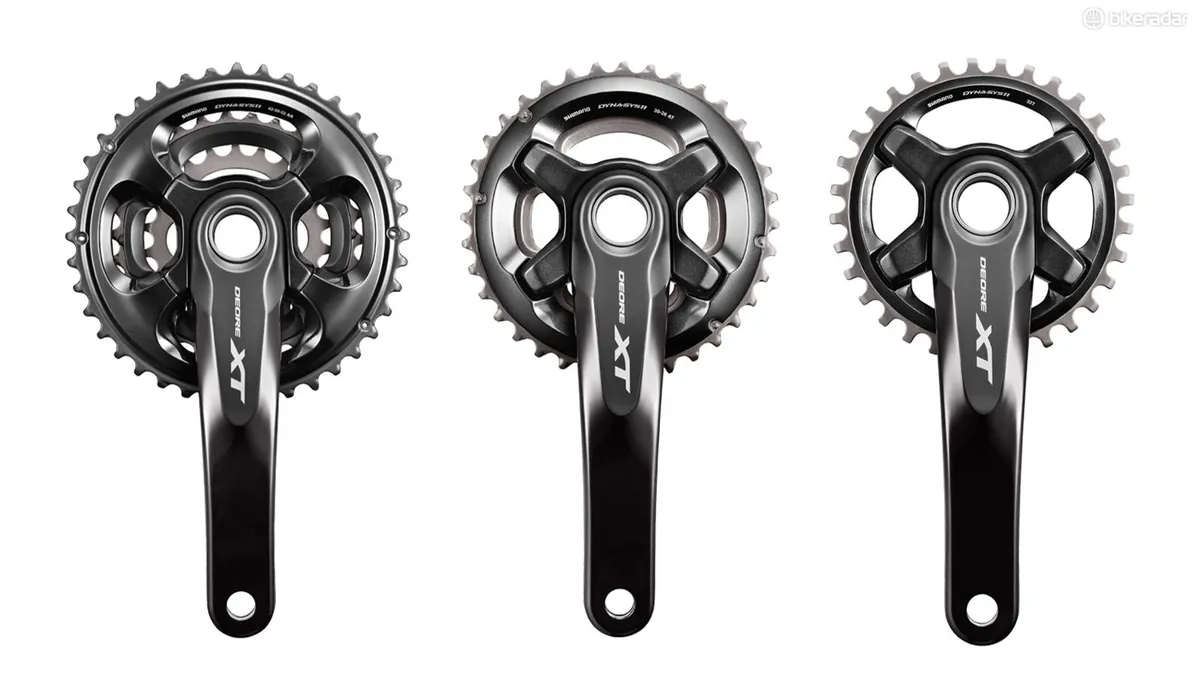
Mountain bike cranksets can be divided into three categories by their number of chainrings.
Triple
The first is the triple – the old classic. As the name implies, it consists of three chainrings, the largest often being a 42- or 44-tooth outer ring.
The middle ring is usually a 32 or 34 and the smallest, inside ring, is often a 22- or 24-tooth.
This setup can offer the largest range of gears, but there is significant redundancy in terms of gear ratios. Cross-chaining is also a concern with a triple if the lowest or highest chainring is selected with the opposite lowest or highest sprocket on the cassette.
Cranksets with three chainrings aren't found on modern high-end mountain bikes. They are disappearing from the entry-level market and double- and single-ring drivetrains are quickly becoming the most desired setup and the new normal.
Double
Cranksets with two chainrings overtook the triple as the most popular mountain bike crankset when SRAM and Shimano introduced 10-speed drivetrains. Double cranksets offer a narrower gear range with less overlap than a triple.
They use a smaller inner ring (22- to 28-tooth), while the larger outside cog offers a gear that’s generally well-suited to faster riding (34- to 36-tooth).
Double cranksets are found from entry-level bikes through to high-end models but their popularity is on the wane too.
Single
The most significant trend in mountain bike drivetrains over the past five years has been the movement toward wide-range 1x drivetrains with a single chainring.
Commonly referred to as a '1x' (one-by), this arrangement has been popular on downhill mountain bikes for years, where large mountain bike gear ranges aren’t needed and chain security (that is, no dropped chains) is very important.
Following SRAM's launch of XX1 and the introduction of subsequent wide-range 1x11 and 1x12 groups, the single-ring drivetrain has now become the new norm on high- to mid-level mountain bikes, and is increasingly found on entry-level bikes too, thanks to the introduction of SX Eagle and NX Eagle 12-speed drivetrains.
Chainring size ranges vary widely, depending on the intended use, from 38-tooth chainrings for strong cross-country racers down to 28- and even 26-tooth chainrings on some fat bikes. Most bikes with 1x drivetrains come with 32- or 30-tooth chainrings.
One key attribute of 1x drivetrains is the use of a chainring with tall, unramped teeth (since there's no need to shift between chainrings) and alternating tooth widths that match up with the inner and outer links of the chain.
Both of these features are designed to keep the chain in place without the aid of a front derailleur or chain guide.
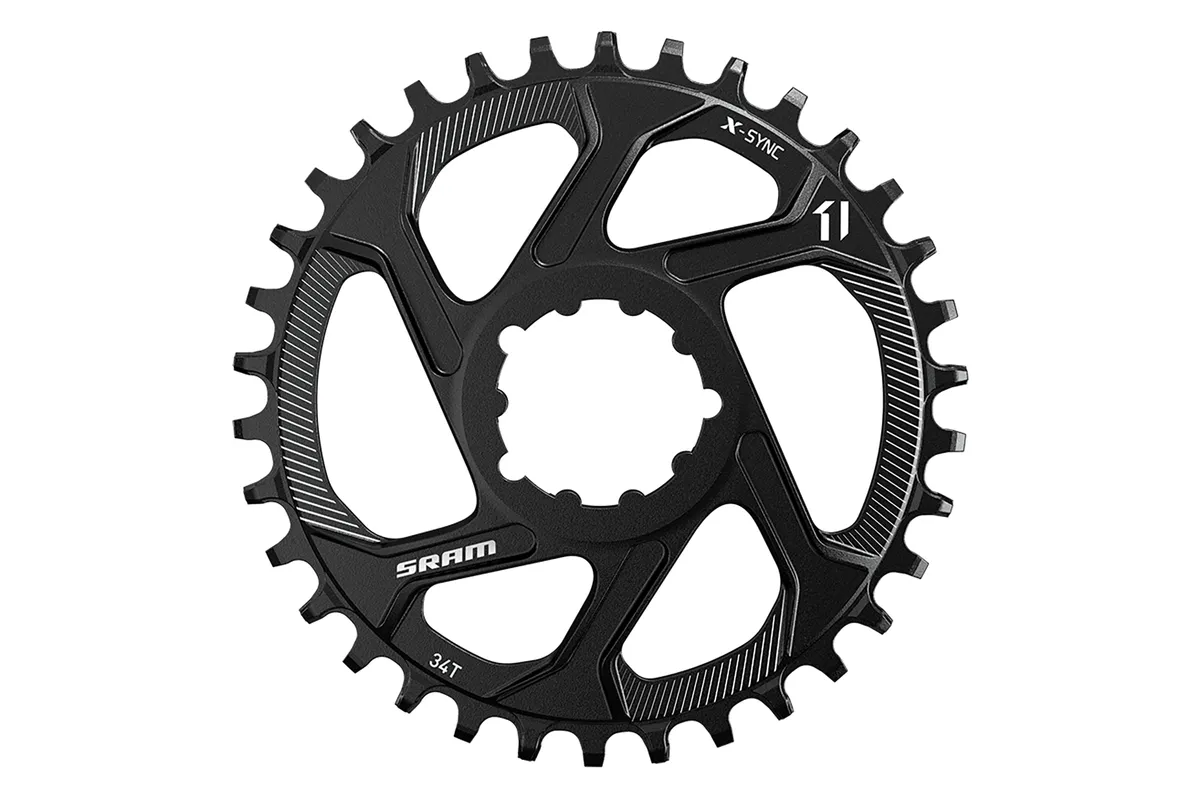
By removing the front derailleur and corresponding shifter, a single-ring drivetrain is less complex as well as lighter. Many novice riders find 1x drivetrains easier to operate as well.
Mountain bike bottom bracket
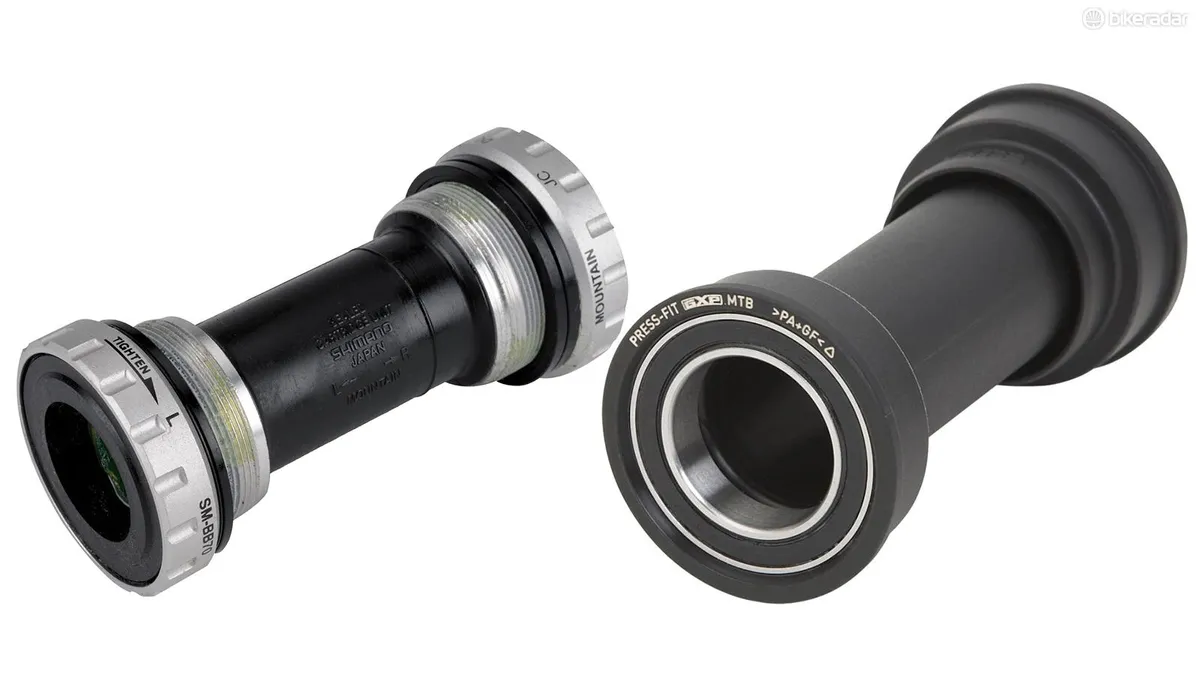
A crankset won't get you very far without bearings to spin on. These bearings are pressed or threaded into the mountain bike's bottom bracket shell.
Bottom brackets are available in a staggering array of configurations — you might find our complete guide to bottom brackets useful.
Mountain bike cassettes
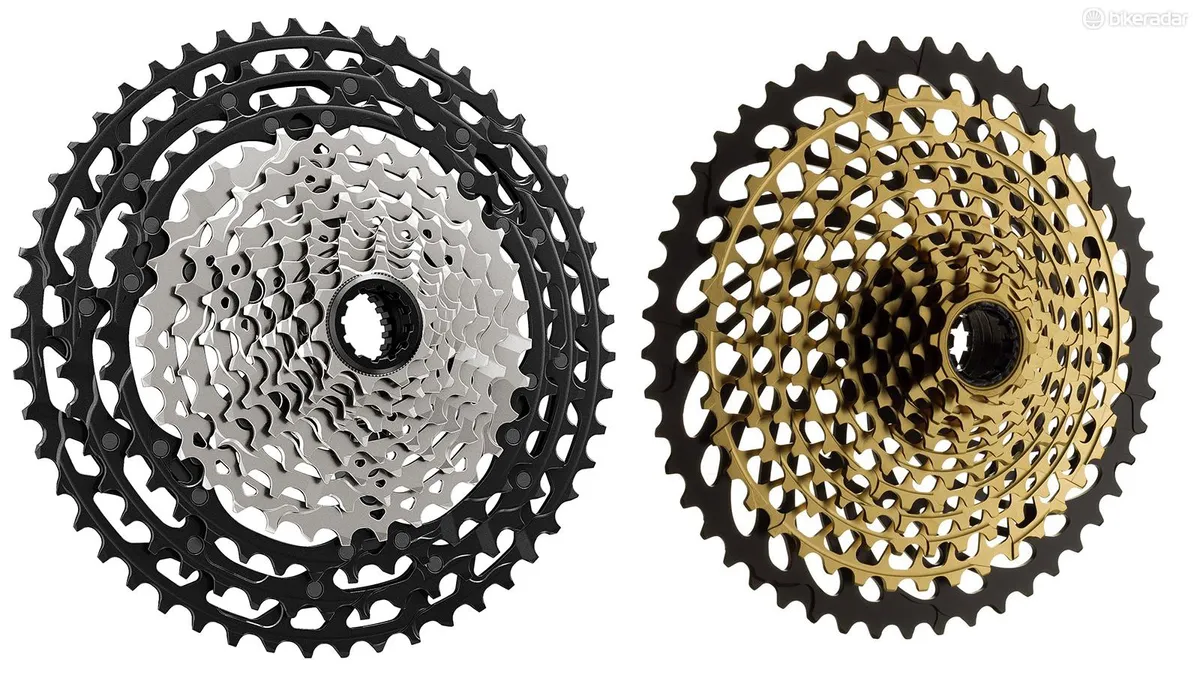
Cassettes come in a wide range of sizes and speeds. Like the crankset, cassette choice is often determined by the bike’s intended riding style and price.
Mountain bike cassettes can be found in 7- through 12-speed versions. They are usually referred to by the smallest and largest cogs to provide an indication of the total range, e.g. 11-32t or 10-50t.
Aside from downhill bikes, which often use very narrow-range cassettes, most mountain bikes favour a cassette with a wide spread of gears to make climbing easier. The most commonly found ranges on bikes with double or triple cranksets are 11- to 34- or 36-tooth.
Single-ring drivetrains go much wider, with SRAM's 12-speed Eagle-branded drivetrains providing up to a 10-52t spread (11-50t on SX and NX Eagle), while Shimano offers an 11-46t range on its 11-speed SLX and XT groups and a 10-51t option on its latest 12-speed XTR, XT and SLX groups.
Mountain bike chains
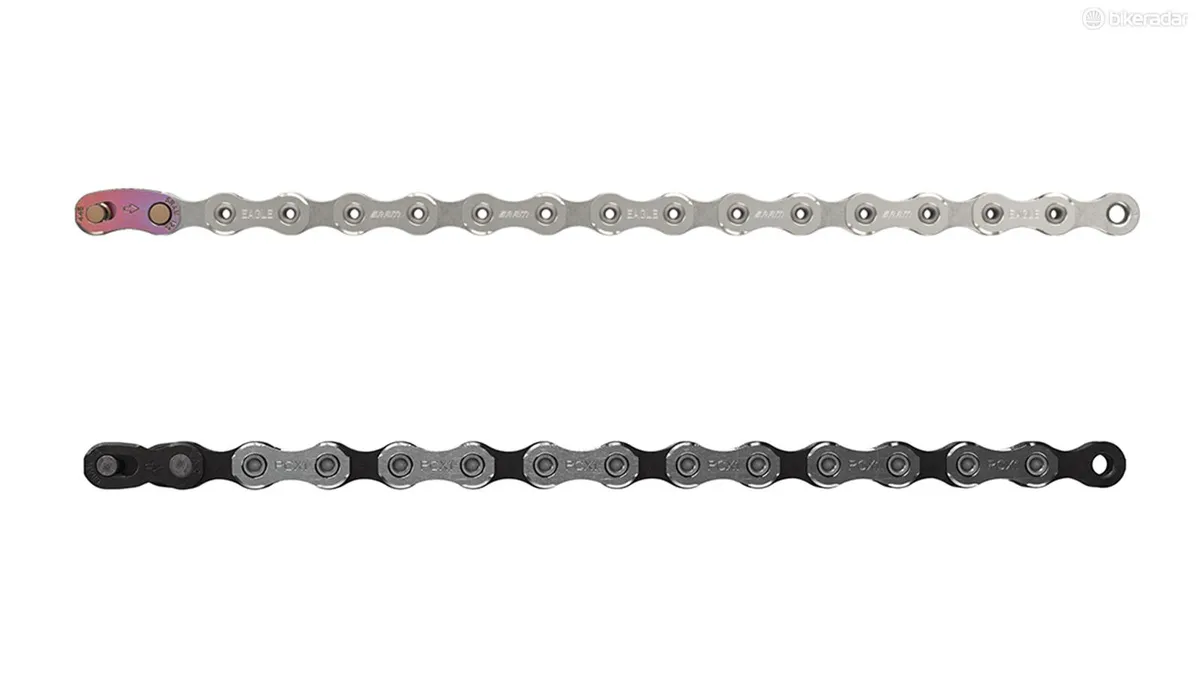
The groupset brand and the number of gears dictate the type of chain you need. In general, as the number of gears increases, the spacing between the cogs shrinks and so the chain becomes narrower as well.
Because of this, you should only run a chain designed specifically for the number of cogs on your cassette – don't use a 9-speed chain on a 10-speed drivetrain, or an 11-speed chain on a 12-speed drivetrain. Some chains are even directional and need mounting in a specific orientation, so check upon install.
More expensive chains often have smoother, more durable and corrosion-resistant coatings, and save weight with hollow links and pins. With that in mind, chains are the first part of a drivetrain to wear out, so it's often best to invest in a mid-level chain.
- Best workshop chain tools | Chain breakers rated by our experts
- How to replace your worn out bicycle chain
Mountain bike derailleurs
Derailleurs are the components that move the chain between cogs on the cassette and chainrings on the crankset. Each brand offers its own design, but the principle is generally the same.
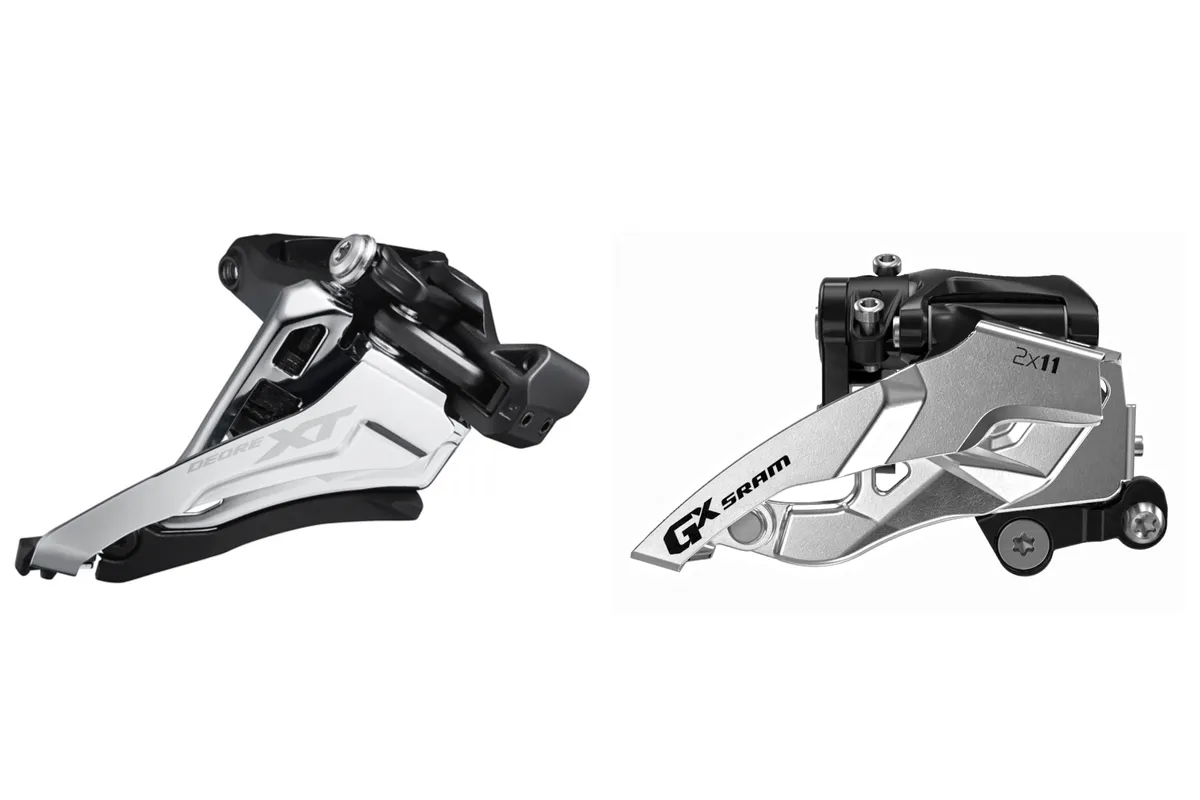
When pressed, the shifter pulls or releases a cable, which moves the derailleur, derailing the chain and repositioning it in a different gear.
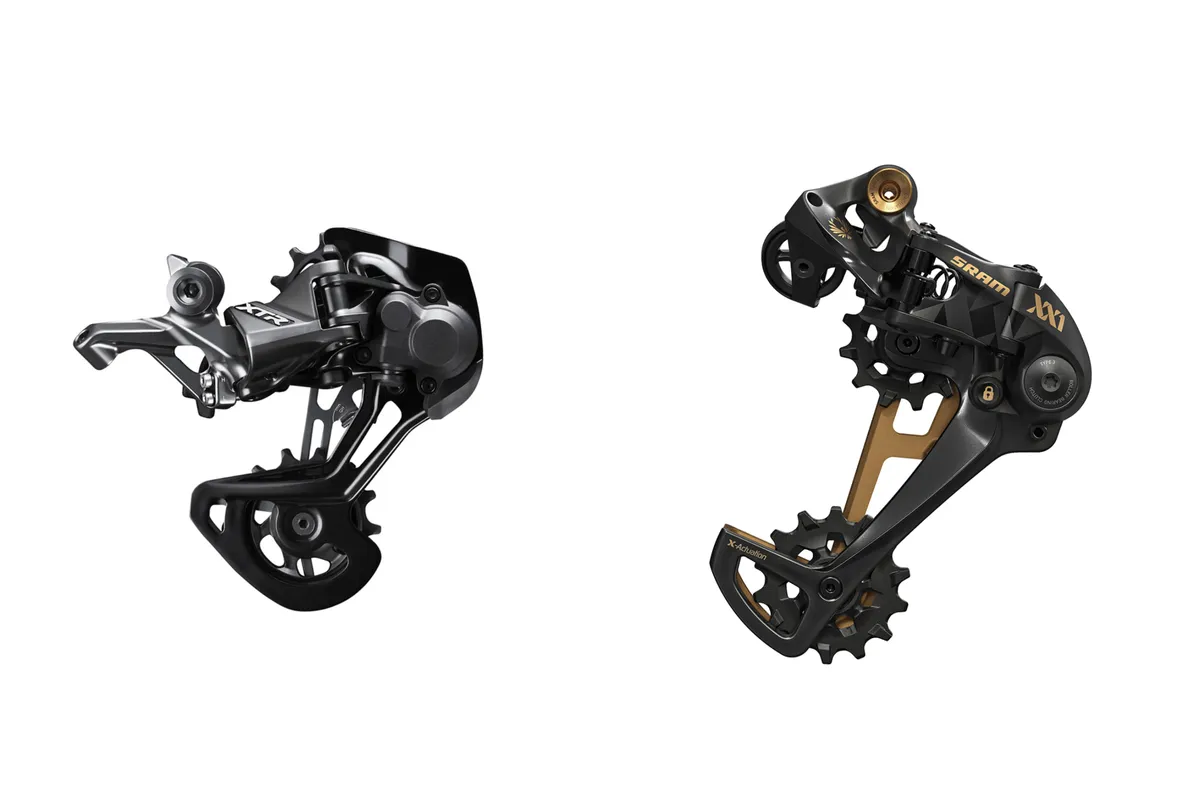
Cables are no longer the only way to control derailleurs. Shimano offers electronically actuated derailleurs on XTR Di2 as well as XT Di2, which use electrical wires connected to the shifter(s). SRAM's AXS groupsets are completely wireless.
Mountain bike shifters
As previously mentioned, shift levers are used to operate a bicycle's derailleurs. Shimano and SRAM use different designs, and while they all shift gears, they each have a particular way of doing it.

While mechanically different, both SRAM and Shimano offer 'trigger shifters'. This name is a bit misleading because both companies have refined the lever ergonomics to shift both levers with the thumb, rather than also relying on the rider's index or 'trigger' finger.
The benefit of this approach is that it allows a rider to shift while also keeping their index finger on the brake lever.
SRAM offers two systems for its mechanical shifters, Trigger and Grip Shift. The trigger system is more common. Grip Shift functions like a throttle, twisting back and forth to shift. This system has lost popularity in recent years but still holds a loyal following in cross-country racing, since the system is very light and allows riders to shift across the cassette quickly.
SRAM AXS introduced a new design with three buttons, two of which are operated by a paddle that rocks up or down, with the third being a button on the back – the buttons' operation is customisable in SRAM's dedicated app.
Shimano's Di2 uses electronic switches too and can also be customised via its app.
Di2 can, for example, make use of Shimano's Synchro Shift technology, which allows the rider to use a single shift lever to control the front and rear derailleurs. The system's computer shifts into the optimal chainring and cassette sprocket to keep the rider's cadence relatively constant.
Choosing a mountain bike groupset: price versus performance
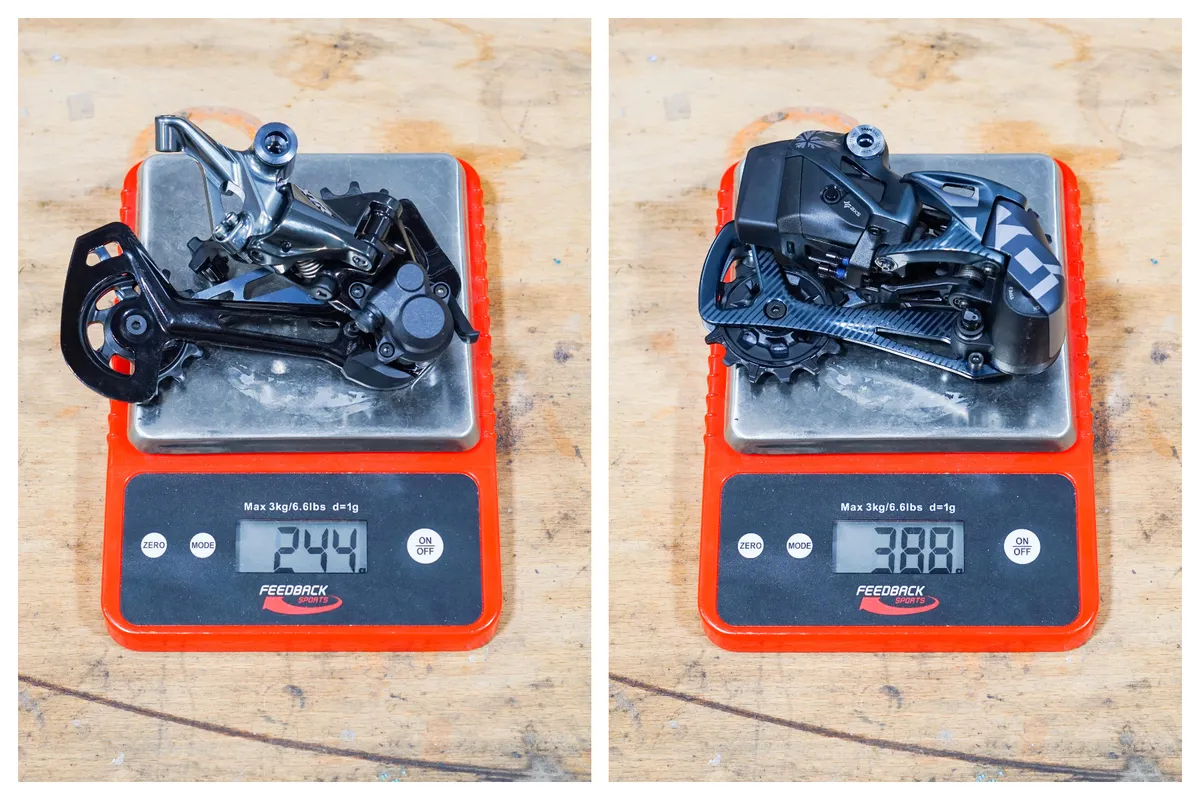
Like most components, groupsets vary in price a great deal. So what benefits do more expensive groupsets bring?
Groupset weight
Keith Bontrager famously said of bicycle parts: "Strong. Light. Cheap. Pick two."
A lighter bike will always accelerate, climb and brake better than a heavier one, but without sacrificing strength, something has to give. Whether you're looking at mountain bike drivetrains, wheels or even complete bikes, reduced weight is often the major factor in increased cost.
Generally, with mountain bike groups, the more you spend, the lighter they get. Often the performance of the groupset plateaus at the second tier from the top, with reduced weight being the reason for the extra expense.
For example, the difference between Shimano's top two tiers, XT and XTR, is around 300g (excluding brakes), while the difference between SRAM's flagship XX1 Eagle and second-tier X01 Eagle drivetrains is closer to 46g (excluding brakes and bottom bracket).
These weight differences are the result of more expensive materials and refined, or more time-consuming, manufacturing processes.
In addition to further machining, hole-drilling and high precision, more expensive components often use materials such as carbon fibre, titanium, lightweight aluminium and ceramic bearings to achieve class-leading low weights.
Groupset durability
If you're spending more money on a mountain bike group, you'd expect it to outlast a cheaper option.
Durability does improve with price, but our experience is that durability also plateaus at the second-tier options. XT in the case of Shimano and X01 in the case of SRAM.
In some instances, component durability can actually decline at the most expensive option, where absolute weight savings sometimes trump product longevity.
The more expensive technical components are built with greater precision, refinement and materials that lend themselves to greater longevity. This is apparent in derailleurs and shifters, where the cheaper options will develop play and slop overtime, whereas better parts often remain like new for many years of use.
Wear items, such as cassettes and chainrings, however, are often the reverse of this. Cheaper options are made of heavier, but more durable steels, while the more expensive versions are made with lighter, but softer, aluminium and titanium metals.
Groupset performance
In addition to the benefits of reduced weight, more expensive mountain bike groupsets find other ways of increasing performance.
Most noticeably, higher-priced options provide a smoother, more precise and quicker shift between gears.
This includes reduced effort at the lever, something that becomes apparent once you've been on the bike for a few hours. It's an area where electronic gears are going to set a new benchmark – ultimate precision and speed at the simple push of a button.
Another performance example is increased crankset stiffness to provide crisper shifting and more efficient power transfer from the pedals to the rear wheel. This is achieved with more complex designs and materials that increase strength and stiffness without adding weight.
Additional groupset features
Besides offering extra gears, it's common for the more expensive groups to offer additional features.
Clutch-equipped rear derailleurs, such as Shadow RD Plus from Shimano or Type-3 Roller Bearing Clutch from SRAM are an example of a technology that is offered on these brands' groupsets, from Deore and NX Eagle upwards.
The clutch keeps the chain taut, which improves shifting over rough terrain, keeping the drivetrain quieter, and reduces the likelihood of dropping a chain.

In reverse of this, gear indicators are a feature often lost as the groupset price increases. The theory being that more experienced riders use gears based on ‘feel’ and don’t need numbers or indicators to help them.
Discipline-focused options
With mountain biking spanning so many individual disciplines, it shouldn’t be too surprising to find that what works perfectly for climbing steep hills in cross-country may not be ideal for descending cliff faces in downhill.
This is why discipline-specific groupsets now exist for the more extreme riding styles. We’ll cover these below in the individual brand hierarchies.
Shimano's mountain bike groupsets
Japanese manufacturer Shimano offers the widest range of groupsets for mountain biking.
Shimano's mountain bike groupset hierarchy, from least expensive and technologically advanced to most, is as follows:
- Shimano Tourney
- Shimano Altus M2000
- Shimano Acera M3000
- Shimano Alivio M3100
- Shimano Cues U6000
- Shimano Deore M6100, M5100, M4100
- Shimano SLX M7100
- Shimano Deore XT M8050
- Shimano Deore XT M8100
- Shimano XTR M9050
- Shimano XTR M9100
Shimano also offers two downhill-specific groupsets:
- Shimano Zee M640
- Shimano Saint M820
Shimano Tourney
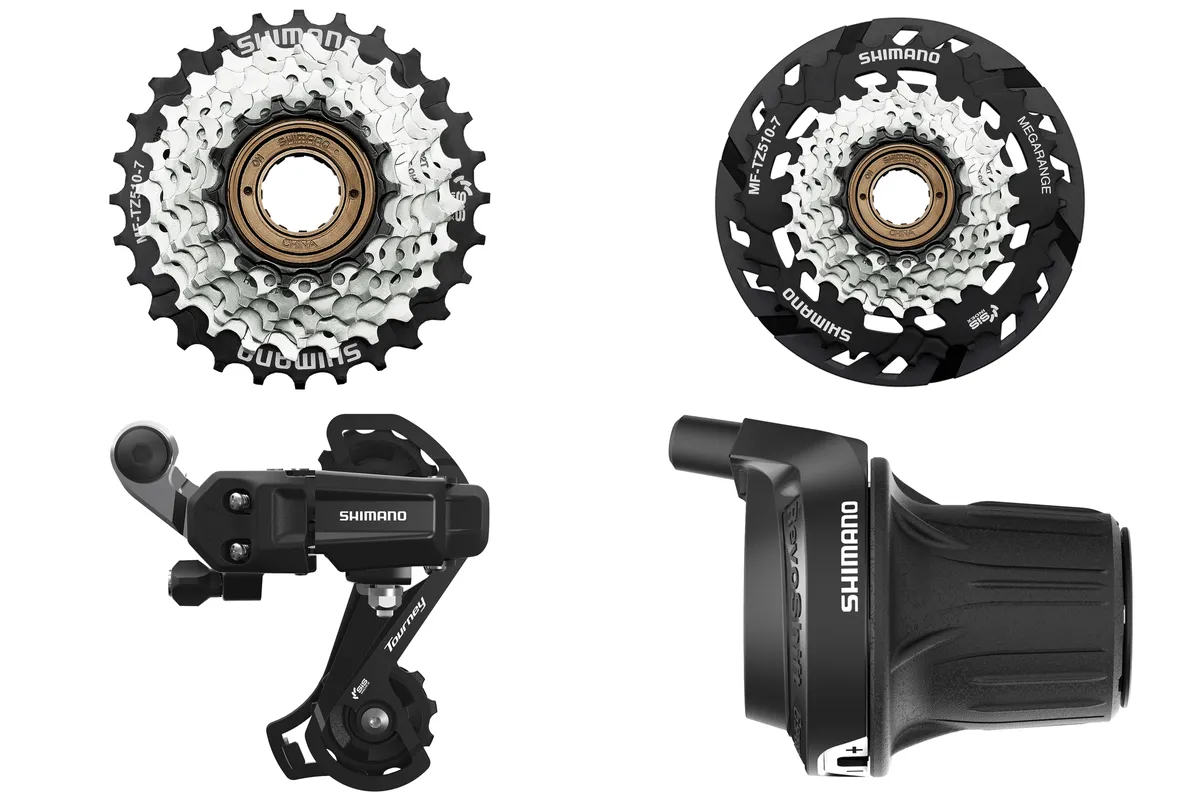
The range starts with Tourney, which is usually found on department-store or children’s bikes and comes in a few different configurations depending on its intended application, whether that’s touring, road or very light mountain biking.
Tourney received its latest update in 2020 getting two new 6- and 7-speed mechs and further updates to the shifters, front mechs, cranks and cassettes.
The groupset is available in 6-, 7- and 8-speed systems combined with triple or double cranksets.
Shimano Altus M2000
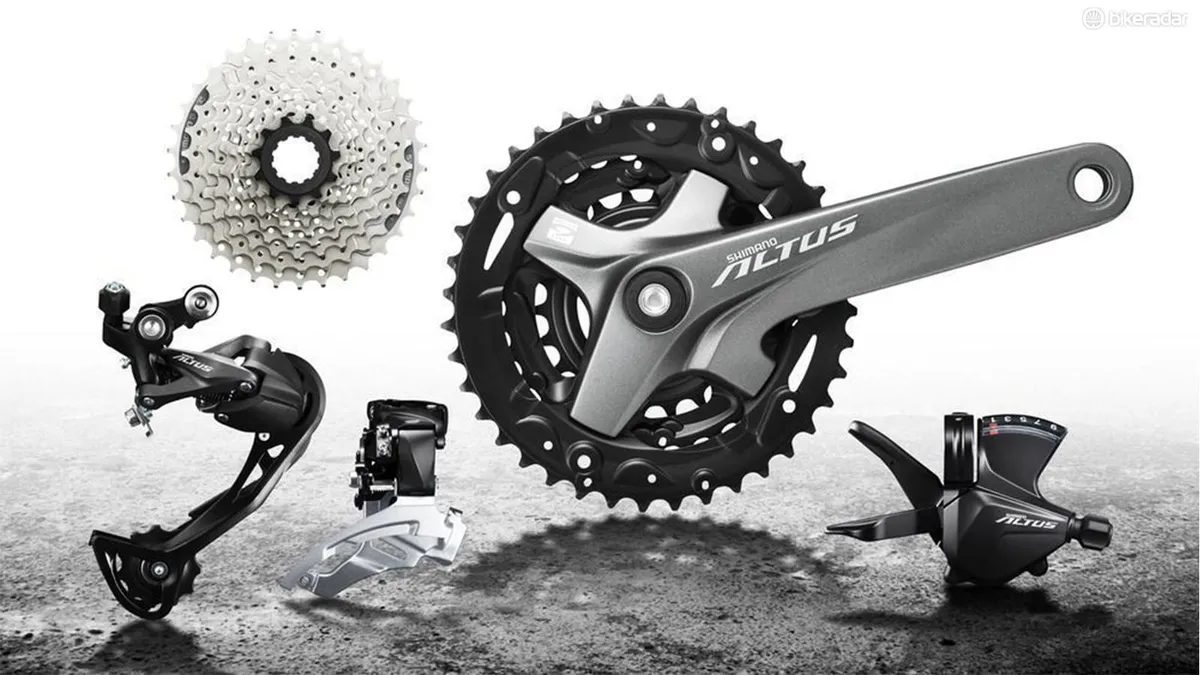
Next is Altus, this is the group you're likely to find on entry-level mountain bikes.
The latest version of Altus offers a 9-speed cassette with a triple crankset with 40/30/22t chainrings.
The Altus rear derailleur doesn't use Shimano's Shadow Plus clutch technology for chain stability, but it does use the Shadow design, which refers to a lower profile to reduce the likelihood of damage from obstacles on the trail.
Shimano Acera M3000
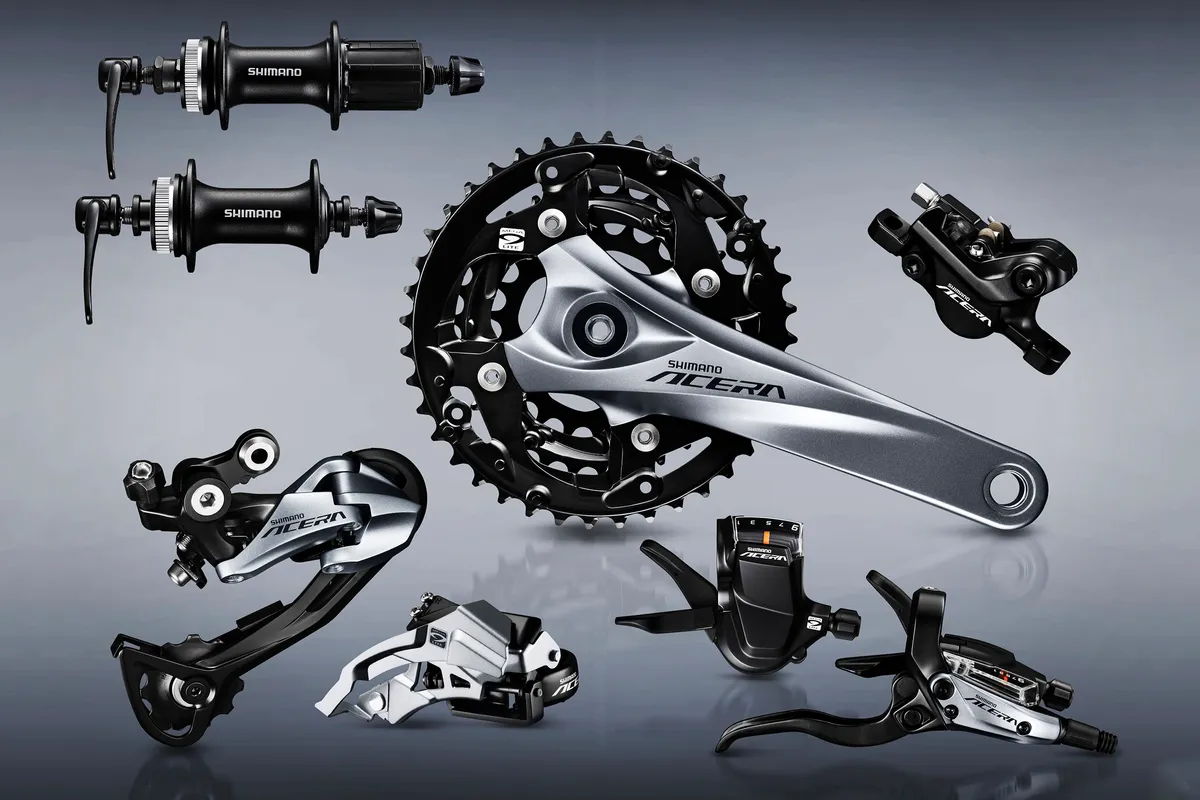
Acera follows next. This group starts to introduce corrosion-resistant materials such as stainless steel on certain components.
It's a 9-speed group that can be used with a 40/30/22 triple crankset or a 36/22 double crankset. It offers a wider range 11-36 cassette.
Shimano Alivio M3100
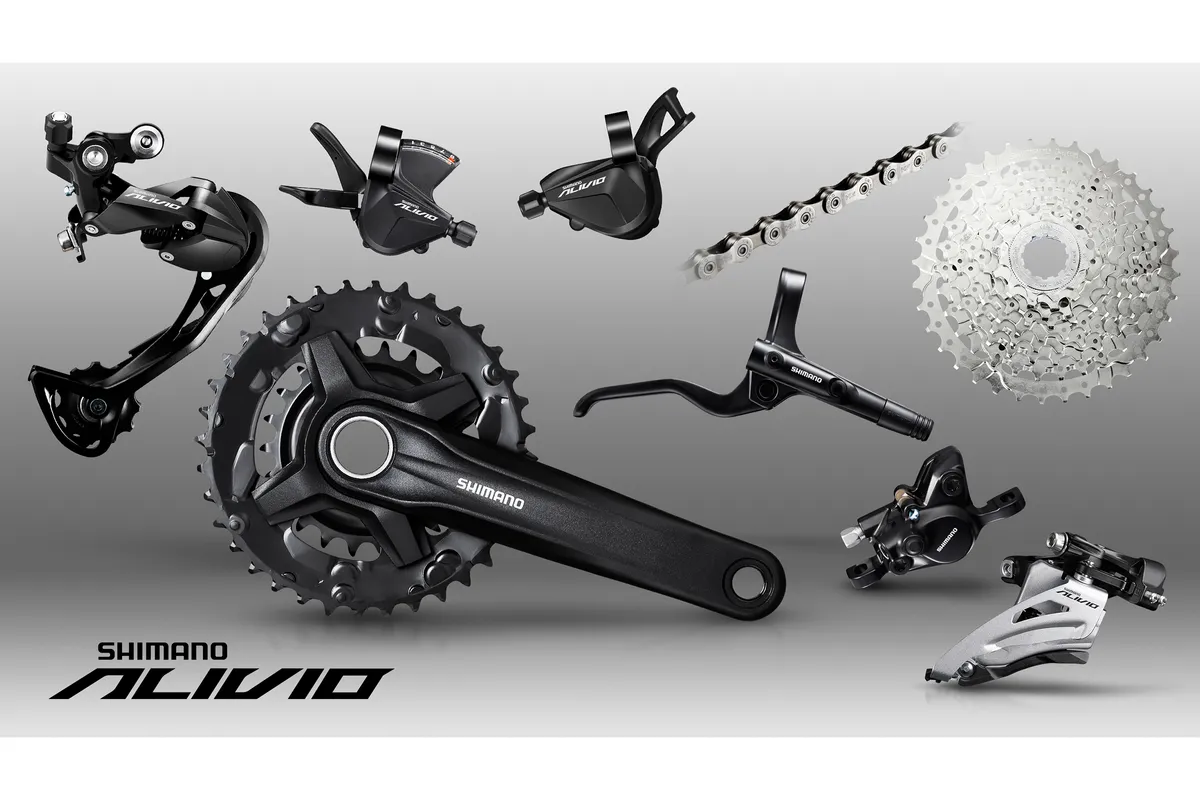
Shimano Alivio sits just above Acera. Like Acera, this 9-speed group is available with a triple or double crankset. We consider Alivio Shimano’s starting point if you’re seeking a trail-worthy mountain bike.
It’s the first of Shimano’s mountain groups to use a two-piece crankset with an external bottom bracket for increased stiffness. Acera uses an Octalink bottom bracket, while Altus and Tourney rely on square-taper bottom brackets.
For 2020, the Alivio groupset received some updates to the front derailleurs, gear shifters, cranks, cassette and chain.
Shimano Cues
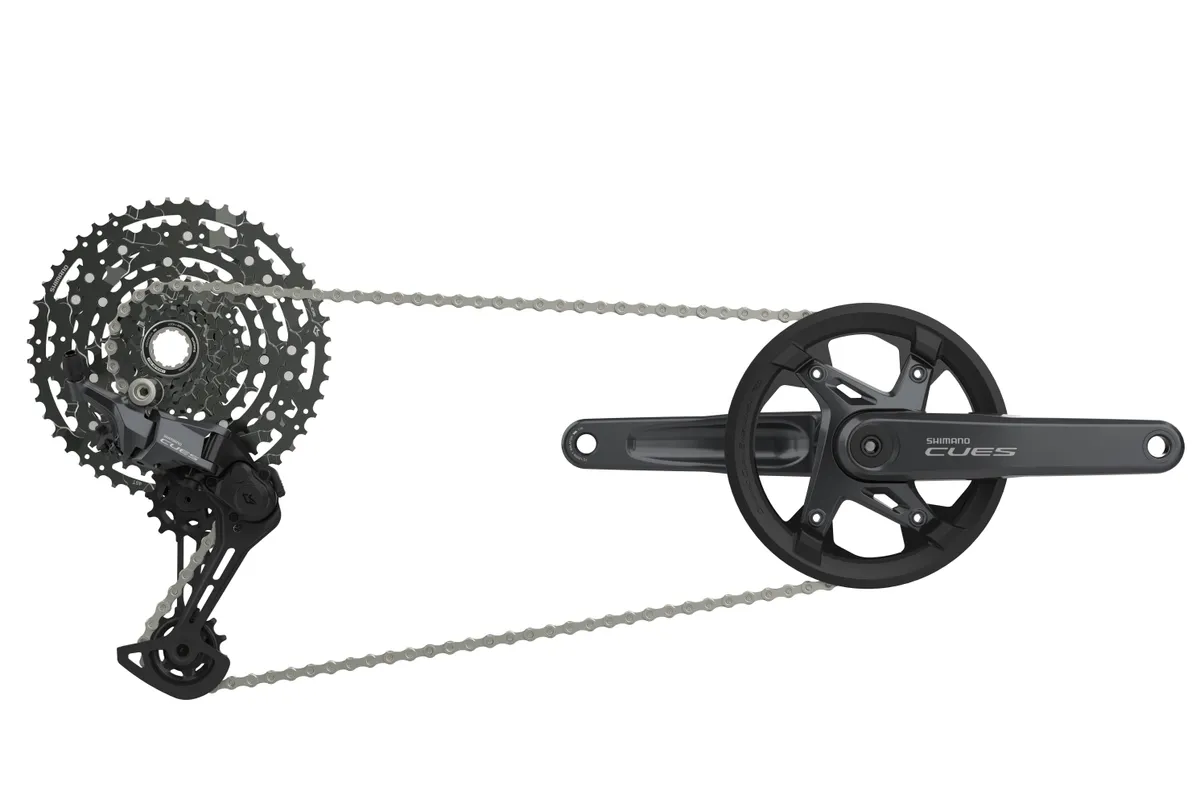
Shimano's Cues groupset spans 9-speed to 11-speed, and is positioned to replace Alivio, Acera and Altus groupsets as well as select components in the Deore mountain bike range, though no new bikes will feature it just yet.
The groupset uses the same cassette spacing and cable pull on all tiers, making parts interchangeable.
Shimano says the U6000 tier is most likely to feature on mountain bikes, and is available with a double or a single chainring, with the rear derailleur able to run as 10-speed or 11-speed with a 50-tooth maximum cassette size for 1x setups.
A selection of cranksets are available in the range, with a two-piece and HollowTech options.
Shimano Deore M6100, M5100, M4100
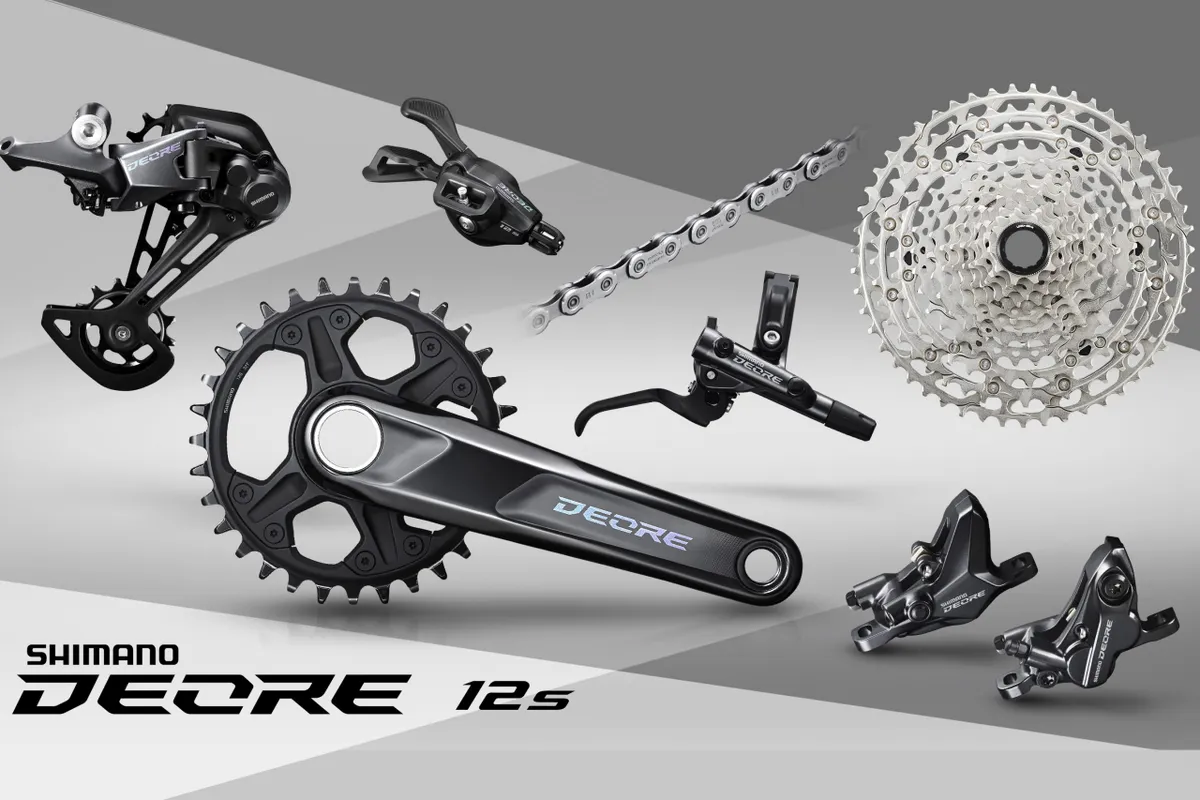
For 2020, the Deore range received a total overhaul, taking the groupset from its original 10-speed only M6000 guise up to 11- and 12-speed, thanks to tech trickled down from SLX, XT and XTR.
The M6100 12-speed is 1x only and features entirely new parts including Microspline cassettes (10-51-tooth range), Shadow RD rear derailleur and a wide range of cranks with Dynamic Chain Engagement tech.
The new 11-speed M5100 groupset looks virtually identical to the new M4100 10-speed groupset and they share the same technology.
They’re both offered in 1x and 2x setups and the 11-speed rear derailleur is compatible with a 51-tooth rear cassette sprocket.
Shimano SLX M7100
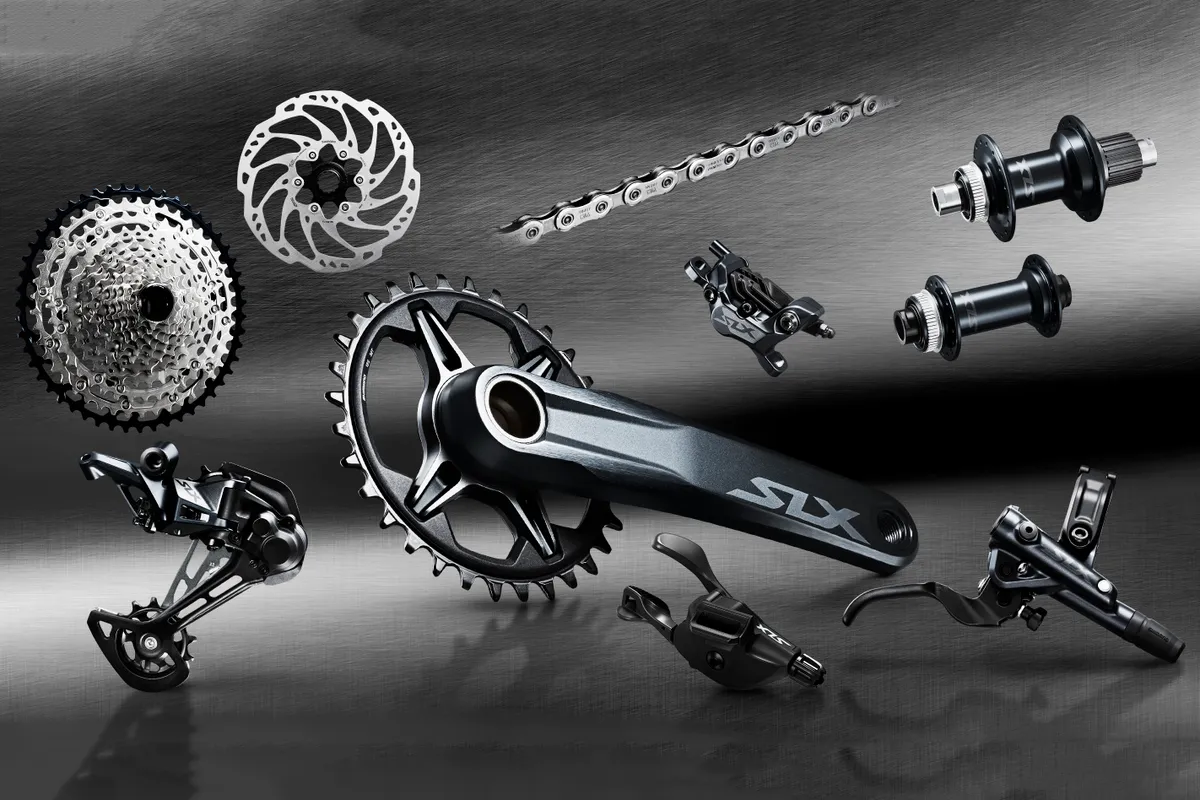
SLX M7100 is a very important group in the Shimano hierarchy. It shares the same number of speeds as XT and XTR in a more budget-friendly package.
Generally speaking, SLX offers the same features and functionality as the upper-end groups at a higher weight and marginally lower shift quality.
Standout features include a 12-speed cassette offered in 10-45 and 10-51t options.
Shimano Deore XT M8050
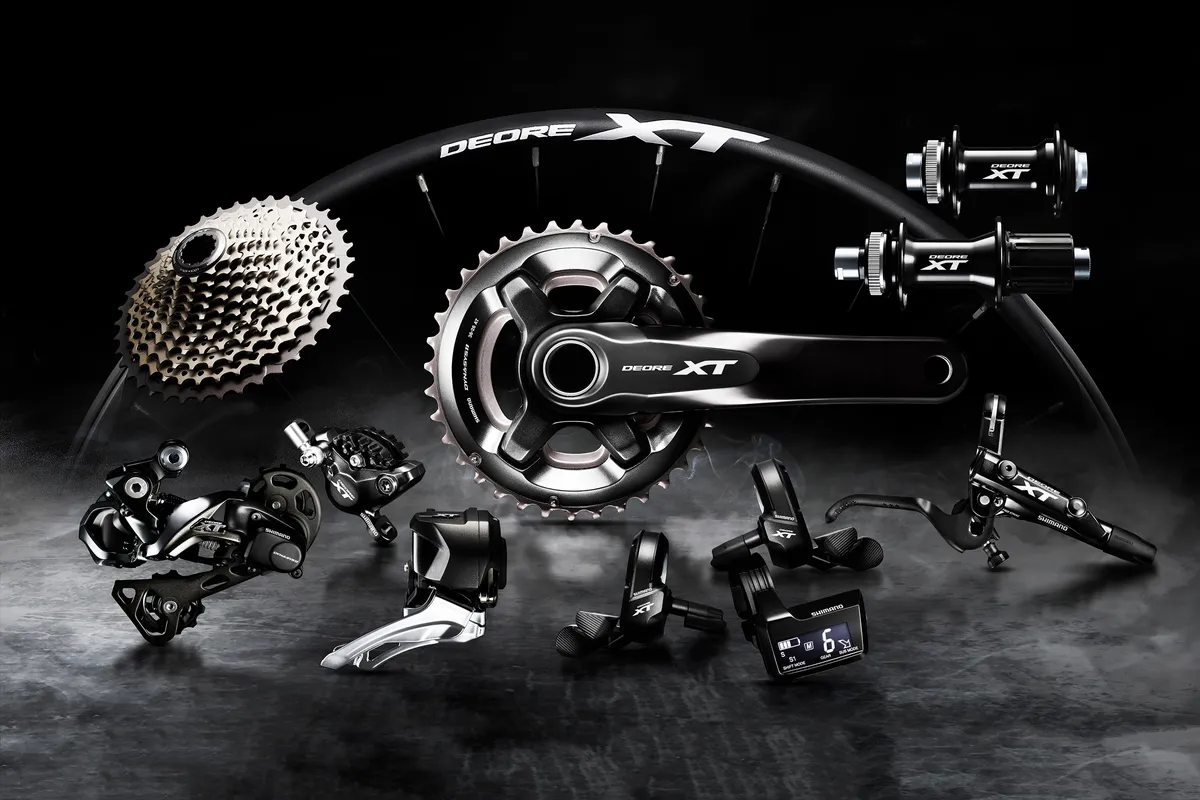
This is the Di2 electronic shifting version of Shimano's XT drivetrain. However, the M8050 series hasn't had the same updates as the cable-operated XT groupset when the M8100 series was released, staying as an 11-speed system.
The advantage of the electronic system is consistent gear shifts and very low maintenance. Another perk of Di2 is sequential shifting, AKA Synchro Shift, whereby both the front and rear derailleurs are operated with a single control, and the system decides whether to shift at the front or rear for the next closest jump.
The Deore XT M8050 Di2 groupset shares the same crankset, cassette, chain and brakes of the respective XT 11-speed mechanical groupsets.
Shimano Deore XT M8100
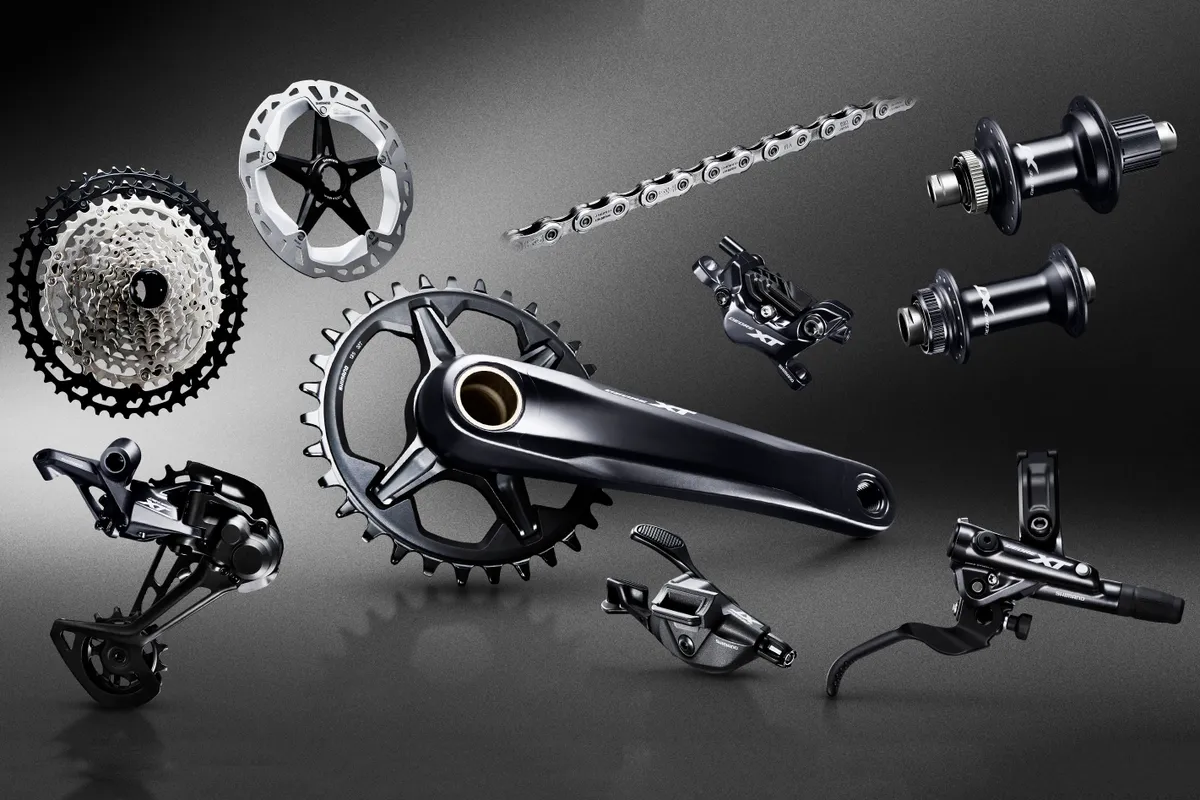
Shimano Deore XT sits one rung below the professional-grade XTR group. This 12-speed group has nearly all the top-end design features as XTR and offers all the performance most riders will ever need, but with a slight weight penalty.
XT is available with either single or double cranksets. Deore XT is available with a wide range 10-45 and 10-51t cassette for 1x and 2x drivetrains.
Shimano XTR M9050
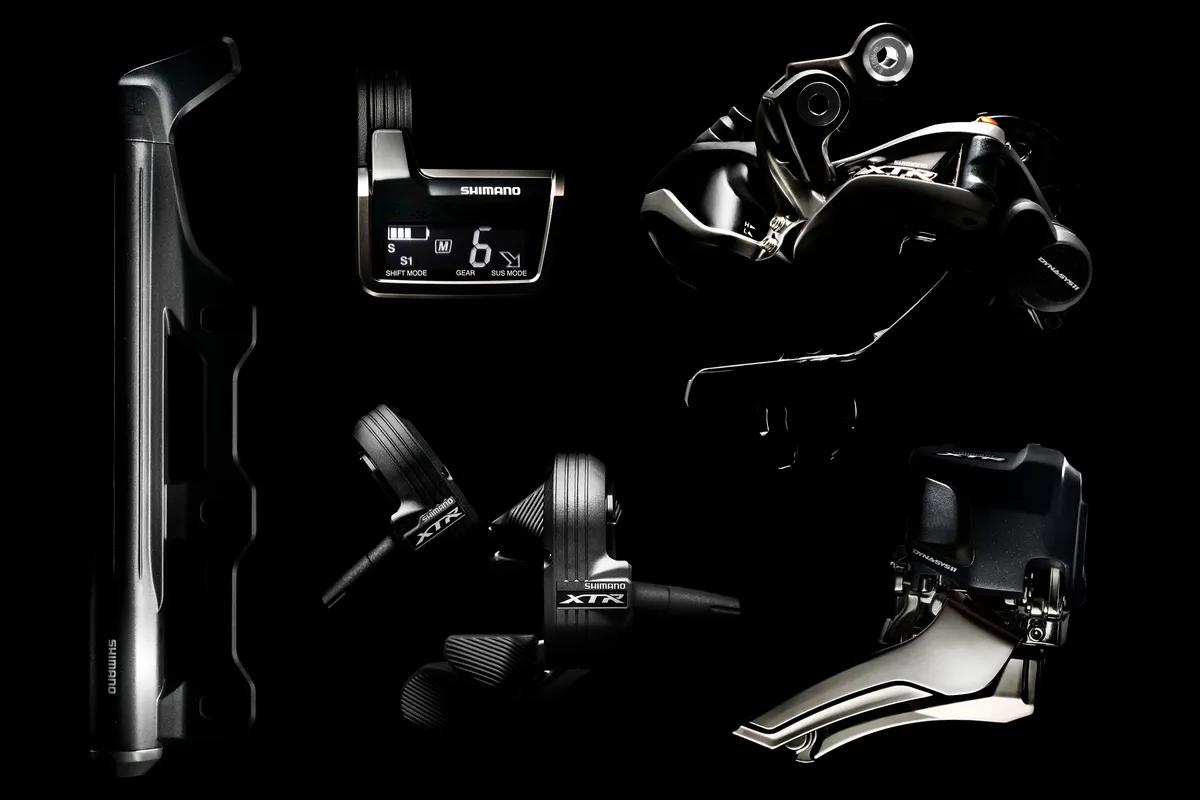
Like the M8050 XT series groupset, Shimano's headline electronically-shifting XTR Di2 M9050 is only 11-speed compatible and shared most of its components with the top-tier M9000 groupset when it was available. Now that XTR's M9100 is 12-speed, a full-house 11-speed XTR groupset is trickier to find.
And like the XT Di2 groupo it has Synchro Shift and can be powered from the in-built battery on an electric mountain bike.
Some downsides include the high cost and remembering to occasionally recharge the battery if you're running the Di2 system on an 'acoustic' bike.
Shimano XTR M9100
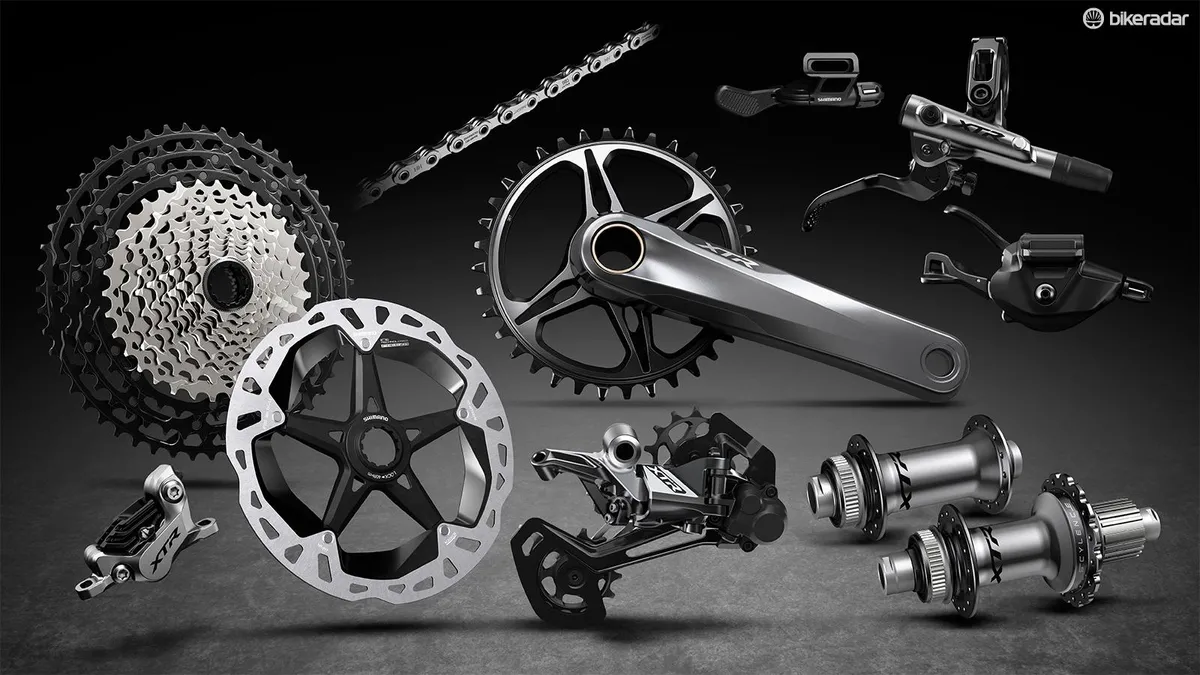
XTR is the pinnacle of Shimano's range and is often used for racing purposes. XTR combines top-end design with lightweight materials, such as high-grade alloys, carbon fibre and titanium. It’s common for XTR to offer features that no other groupset level receives, such as multi-shift release when downshifting.
The latest M9100 group has four different drivetrain options to choose from. There's a wide-range 1x12 drivetrain with a massive 10-51t cassette, a tighter range 1x12 drivetrain with a 10-45t cassette, a 2x12 drivetrain with a 10-45t cassette, and a 1x11 option designed to save weight with a 10-45t cassette.
In the past, XTR was split into Race and Trail categories. The latest M9100 series sees many parts of the group condensed into one line. However, there are still Cross-Country and Enduro categories for brakes as well as pedals.
Cross-Country is all about weight savings, where features such as tool-free brake levers adjust and Ice-Tech brake cooling fins are removed in favour of saved grams.
Enduro is the more ‘everyday’ and feature-packed option, where a few additional grams get you greater brake power and adjustability.
This latest XTR group also uses an entirely new freehub design that's not compatible with previous Shimano mountain bike groups.
Shimano Zee M640

The first of the discipline-specific groups, Zee is Shimano’s entry-level gravity groupset. It's a more affordable version of Saint (see below).
Available only with a 1x crankset, Zee is designed for downhill and freeride. It’s built heavier (and sturdier) than the similarly-priced SLX group.
Unlike SLX, Zee is a 10-speed group.
Shimano Saint M820
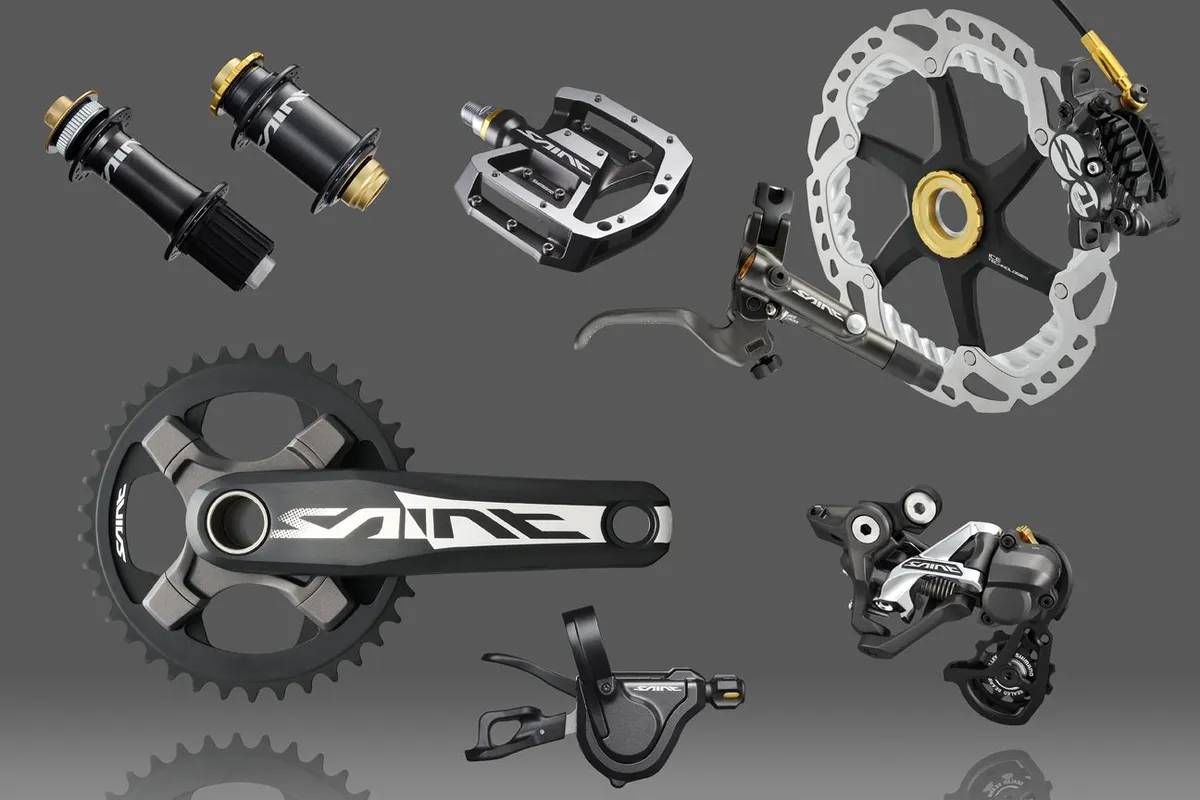
Saint is positioned as a top-level option for those who race downhill.
Saint, like Zee, is a gravity-focused 1x10 group built to handle the abuse of freeride and downhill.
SRAM mountain bike groupsets
SRAM's mountain bike groupset range is divided into two families, with single-chainring groupsets (many of which get a ‘1’ featured in the name) separate from the double and triple options.
Like Shimano, SRAM offers a discipline-specific option too, in the form of X01 DH.
While SRAM’s recent success story is its dedicated single-chainring groupsets, the brand was also a strong advocate of doubles over triples in the past. We'll run through the 2x and 3x groups followed by SRAM's ever-expanding 1x family.
SRAM's latest Eagle technology marked the introduction of 1x 12-speed drivetrains.
Shared features on Eagle-level drivetrains that distinguish them from SRAM's 1x11 groups include either an 11-50t, 10-50t or 10-52t 12-speed cassette, larger, 14-tooth jockey wheels, an improved 'Type 3' clutch mechanism in the rear derailleur and a redesigned 1x-specific chainring with taller, curved teeth and a new profile intended to improve performance at the extreme ranges of the cassette.
From the least to the most technologically advanced, SRAM's groupsets sit in this order:
- SRAM X3
- SRAM X4
- SRAM X5
- SRAM X7
- SRAM X9 (discontinued)
- SRAM SX Eagle
- SRAM NX
- SRAM NX Eagle
- SRAM GX
- SRAM GX Eagle
- SRAM X0 (limited parts remaining in the lineup)
- SRAM X1
- SRAM X01
- SRAM X01 Eagle
- SRAM X01 Eagle AXS
- SRAM XX (discontinued)
- SRAM XX1 (limited parts remaining in the lineup)
- SRAM XX1 Eagle
- SRAM XX1 Eagle AXS
- SRAM X0 T-Type Eagle AXS
- SRAM XX T-Type Eagle AXS
- SRAM XX SL T-Type AXS
There are three specialist SRAM groupsets, two for downhill and one for electric mountain bikes:
- SRAM GX DH
- SRAM X01 DH
- SRAM EX1
SRAM X3

SRAM X3 isn't a complete groupset and is the most basic level of SRAM's componentry, marking the entry-level of SRAM's mountain bike components.
SRAM offers cassettes, chains and cranksets as separate 'non-series' options here.
Designed for 7-, 8- or 9-speed drivetrains, the shifters and derailleurs make heavy use of plastics with metal derailleur cages. These components are suitable for light recreational riding, but not trail use.
SRAM X4

Just like SRAM X3, X4 also isn't a true groupset. With just a shifter set and rear derailleur on offer, it's normal to see other brands mixed in with SRAM X4 parts.
These components are often found on budget bikes and X4 shifters are available in 7- and 8-speed versions and mechs span from 7-speed up to 9-speed.
SRAM X5
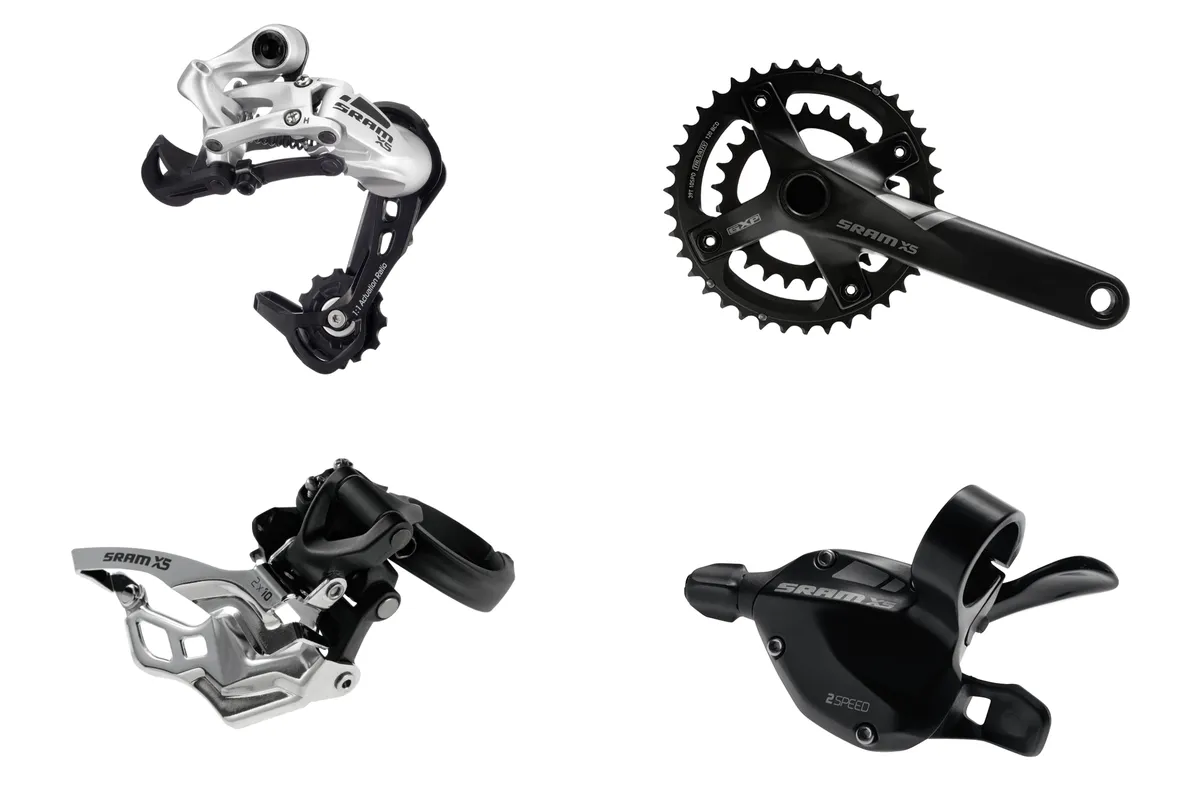
This is the first of SRAM's groups you are likely to find on entry-level mountain bikes. It's a trail-worthy group for recreational riding, though it lacks a clutch on the rear derailleur.
Different versions of the rear mech are compatible with 7-, 8-, 9- and 10-speed cassettes with a maximum cassette sprocket capacity of 36 teeth.
This 10-speed group is available with a 2x or 3x crankset but there is also a 9-speed version of the cranks still available.
SRAM X7
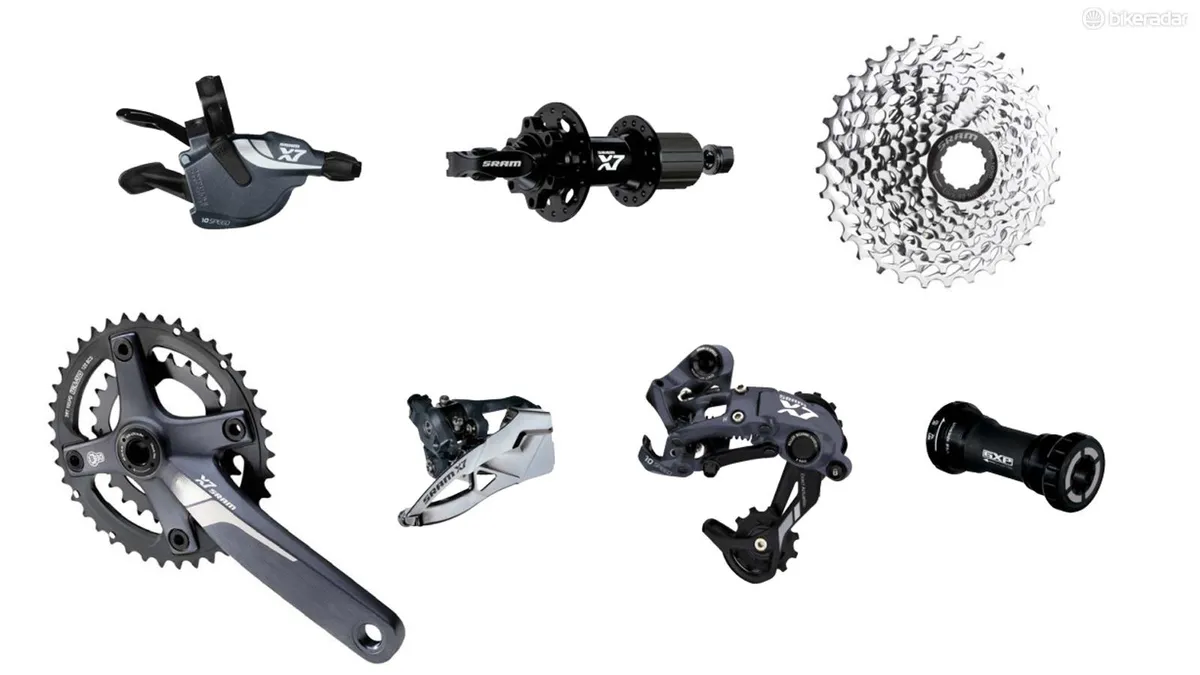
The X7 group has a few additional features that make it stand out from X5. The most important upgrade feature of this 10-speed group is the addition of a clutch on the rear derailleur to improve chain retention.
The X7 shifter has a more precise action than the X5 shifter and is also compatible with SRAM's MatchMaker system, which allows riders to use one clamp to secure shift levers and brakes.
X7 is available with a 2x or 3x crankset.
SRAM X9

Equivalent to Shimano SLX, X9 was the workhorse groupset of SRAM's range. Nearly all the performance features were present at this level, with slightly cheaper construction methods and materials keeping prices down, but the weight was higher.
The X9 group was a durable, trail-worthy 10-speed group available in 2x and 3x configurations.
There was more use of aluminium versus plastic on the shifters and derailleurs, and the X9 crankset featured hollow crankarms to save weight.
SRAM's X9 groupset has now been discontinued.
SRAM SX Eagle

This is the most affordable Eagle groupset from SRAM.
The 12-speed cassette sits on a regular Shimano-style freehub, limiting its smallest sprocket to 11t, rather than 10t on GX Eagle and above. This, however, helps keep its cost lower.
SRAM NX

SRAM NX is the most affordable of SRAM's 1x11 groups. This group features SRAM's narrow/wide X-Sync chainring and a wide range 11-42t cassette.
SRAM NX Eagle
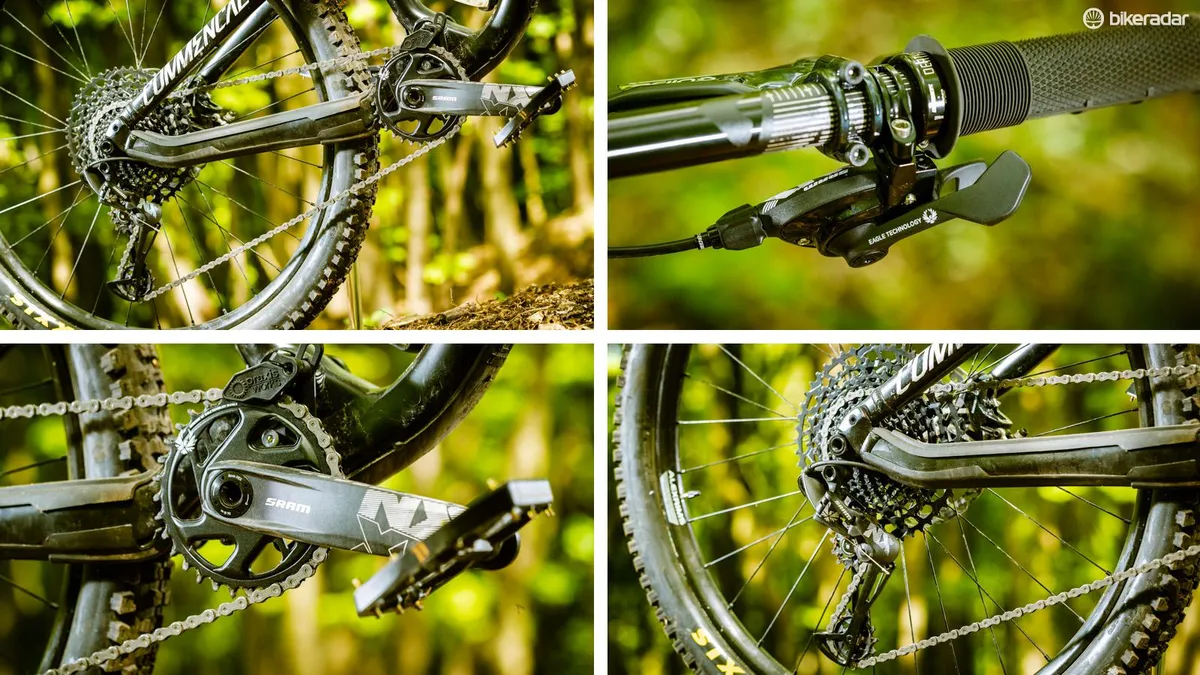
NX Eagle bridges the gap between the GX and SX Eagle drivetrains and features SRAM's brand new derailleur with Type-3 Roller Bearing Clutch technology and can work with either 11- or 10-tooth smallest cassette sprockets.
However, the NX Eagle PG-1230 cassette doesn't use SRAM's XD driver body that can accommodate down to a 10-tooth smallest sprocket. GX Eagle is the first 12-speed drivetrain in SRAM's range with the XD driver tech.
SRAM GX
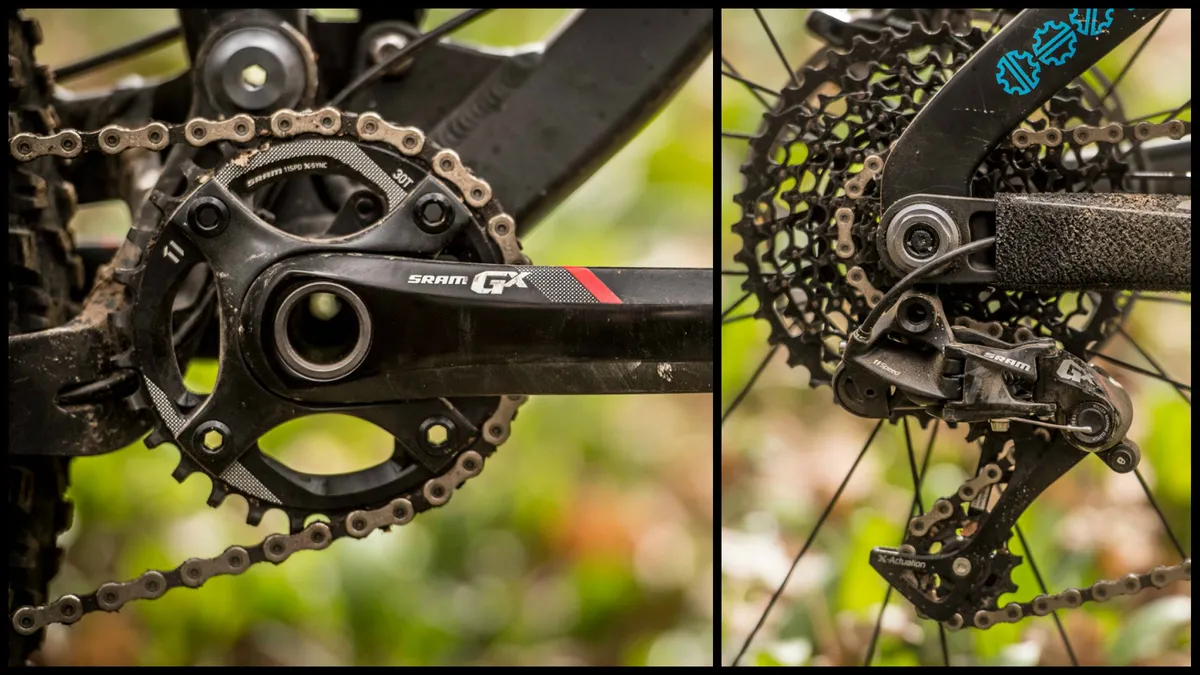
Sharing many designs and internal features of the top-level 1x offerings, SRAM GX components are a popular choice on mid-priced bikes.
Unlike NX, GX is available in 1x11 and 2x11 versions, as well as a dedicated 7-speed downhill group.
SRAM GX Eagle
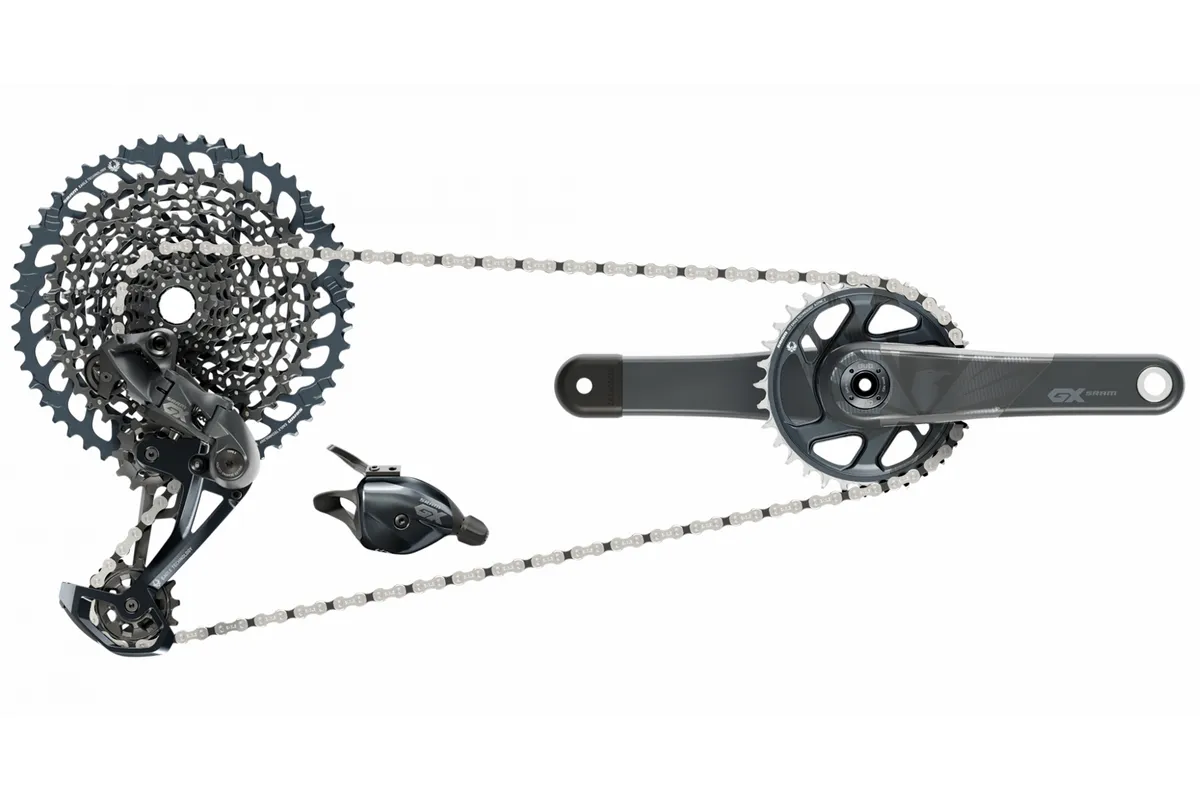
The next addition to SRAM's 1x12 line was the GX Eagle group. It was clear that SRAM was aiming to hammer the final nail in the front derailleur's coffin with the introduction of this budget-minded group.
In June 2020, SRAM updated its GX Eagle groupset with a 10-52-tooth cassette (an increase of two teeth on the lowest, largest cassette sprocket), a redesigned derailleur – so that it can shift into the lowest gear – and updated the cranks, now with both a carbon and alloy version.
As you might guess, the pinned-together GX Eagle cassette is heavier than the heavily machined from one-piece hardened steel X01 and XX1 cassettes.
SRAM GX Eagle AXS

In March 2021, SRAM trickled down its AXS electronic shifting tech to the (slightly) more affordable GX Eagle groupset. It shares much of the tech and the guts of SRAM's higher-priced AXS groupsets, but with heavier steel parts rather than aluminium or carbon fibre.
It's compatible with all SRAM's current Eagle 12-speed components and also with AXS drop-bar shifters for a gravel bike set-up.
As well as a full groupset, it's sold as a GX Eagle upgrade kit, which includes the rear derailleur, shifter and charger, letting you switch to electronic shifting while keeping the rest of your existing 12-speed components.
SRAM X0

Long considered SRAM’s best option for performance without breaking the bank, X0 was a 10-speed groupset that introduced carbon fibre for weight savings and precision machining for shift accuracy. While most often found in a 2x version, SRAM did offer a triple crankset for this group.
The X0 groupset now only lives on in part. A front and rear grip shift gear changer and trigger shifters, and front and rear hubs are the only remaining parts available to buy.
SRAM X1
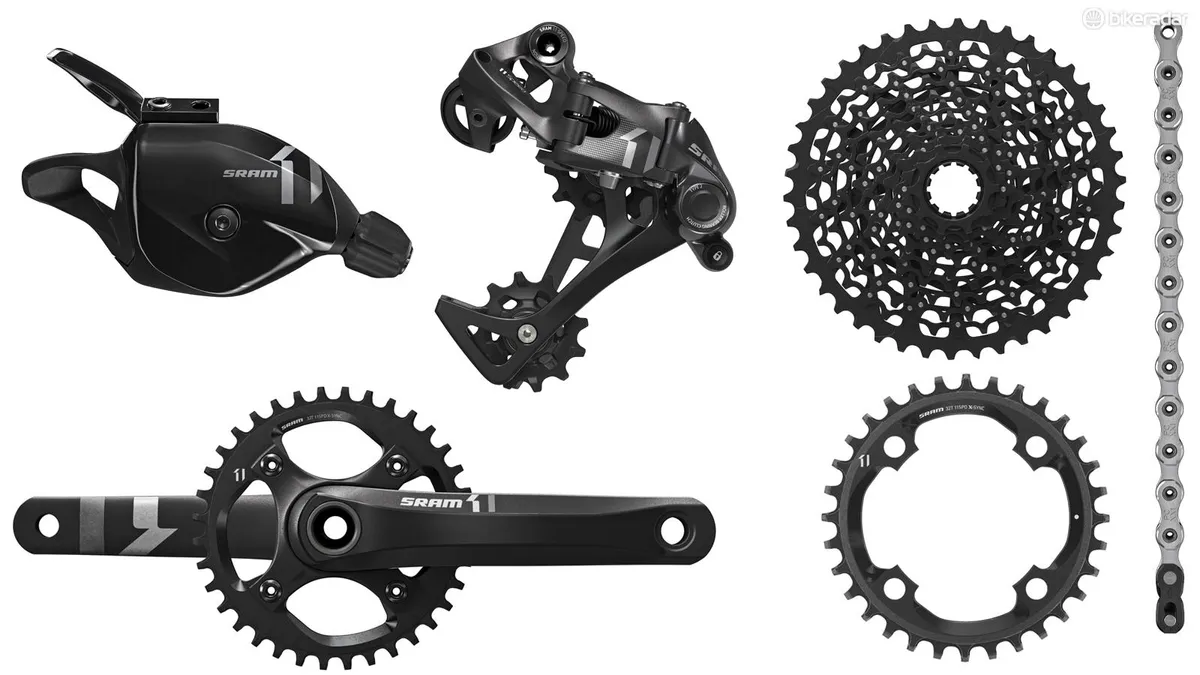
When X1 was first launched it was SRAM's budget-friendly 1x groupset. Since then, NX and GX 1x drivetrains have been introduced, elevating the X1 groupset in SRAM's hierarchy.
The X1 group is a solid choice for riders wanting a reliable 1x11 drivetrain and it shares many of the same features of the top 1x11 groups with a slight weight penalty.
SRAM X01
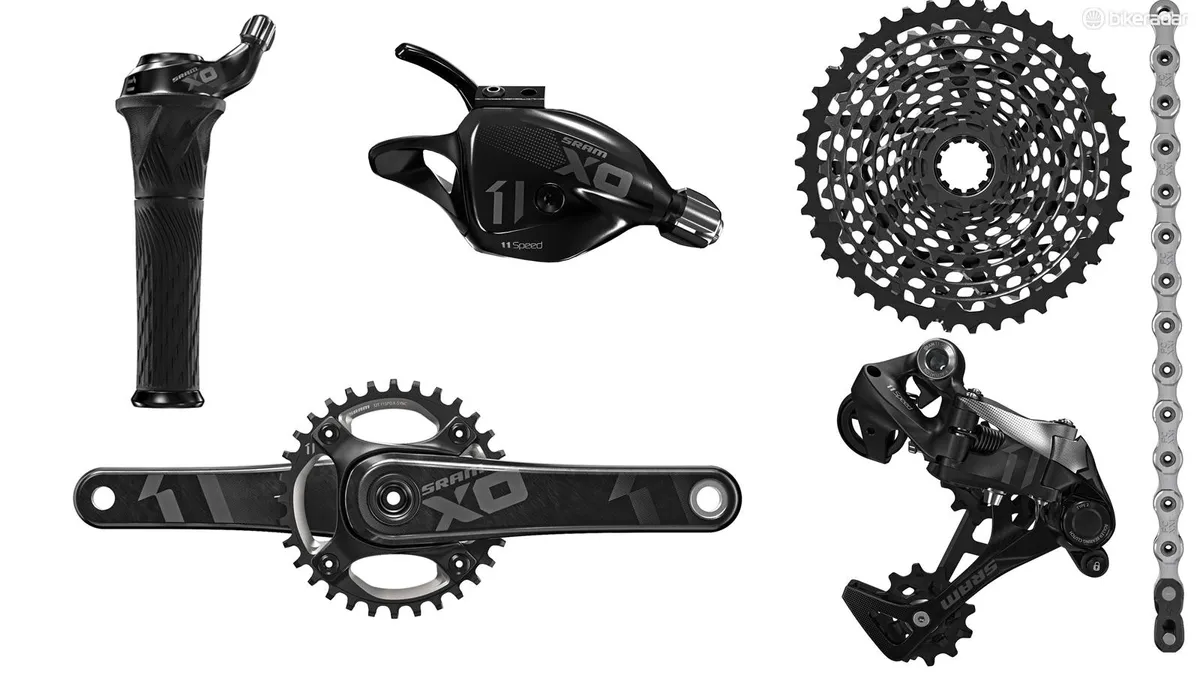
SRAM X01 was perhaps the most sought-after groupset of 2014. X01, along with X1 and XX1, impressed our reviewers thanks to their unique 11-speed setup where the cassette and rear derailleur were greatly different compared to 10-speed setups at the time to offer a huge 10-42t range, without the option of a front derailleur.
The X01 group sits one tier from the top of SRAM's 1x11 family. It's a solid choice for riders who want the performance of the top group but can live with a very minor weight penalty.
SRAM X01 Eagle

Introduced in 2016, SRAM's X01 Eagle 12-speed drivetrain offered a 500 per cent gear range through a huge 10-50t cassette. 'Eagle' is the term SRAM uses to denote its 1x12 mountain bike groups.
The X01 Eagle group is frequently used on high-end trail and enduro bikes, featuring a full aluminium derailleur cage and its cranks have a foam core. It's slightly heavier than its range-topping counterpart, XX1 Eagle, by 46g.
In June 2020, the X01 Eagle groupset got an updated wider-range cassette – now 10-52-tooth – and a new derailleur so that it can shift into the biggest sprocket.
SRAM X01 Eagle AXS
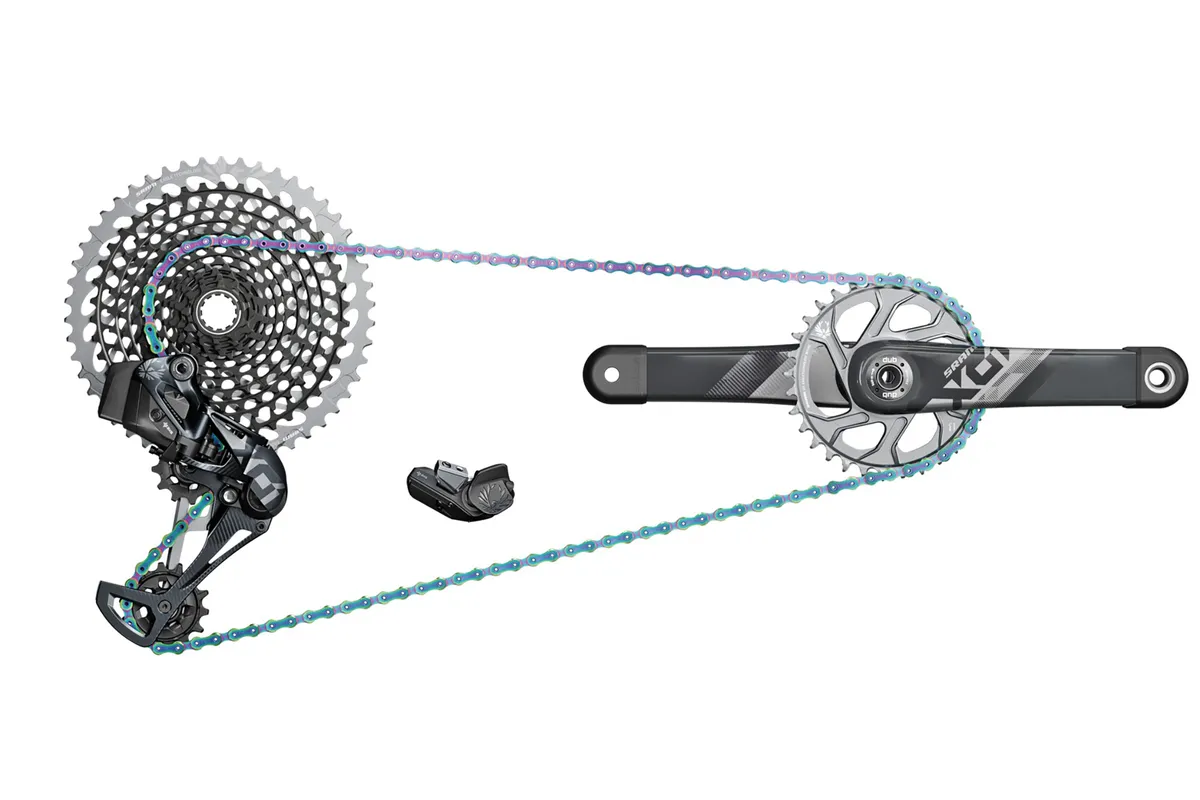
The electronic AXS Eagle system, like its cable-actuated sibling, is designed for more hardcore use such as on all-mountain or enduro bikes than its lighter XX1 Eagle AXS counterpart.
With the increase in strength comes an increase in weight, however functionality across the AXS systems is identical.
SRAM XX
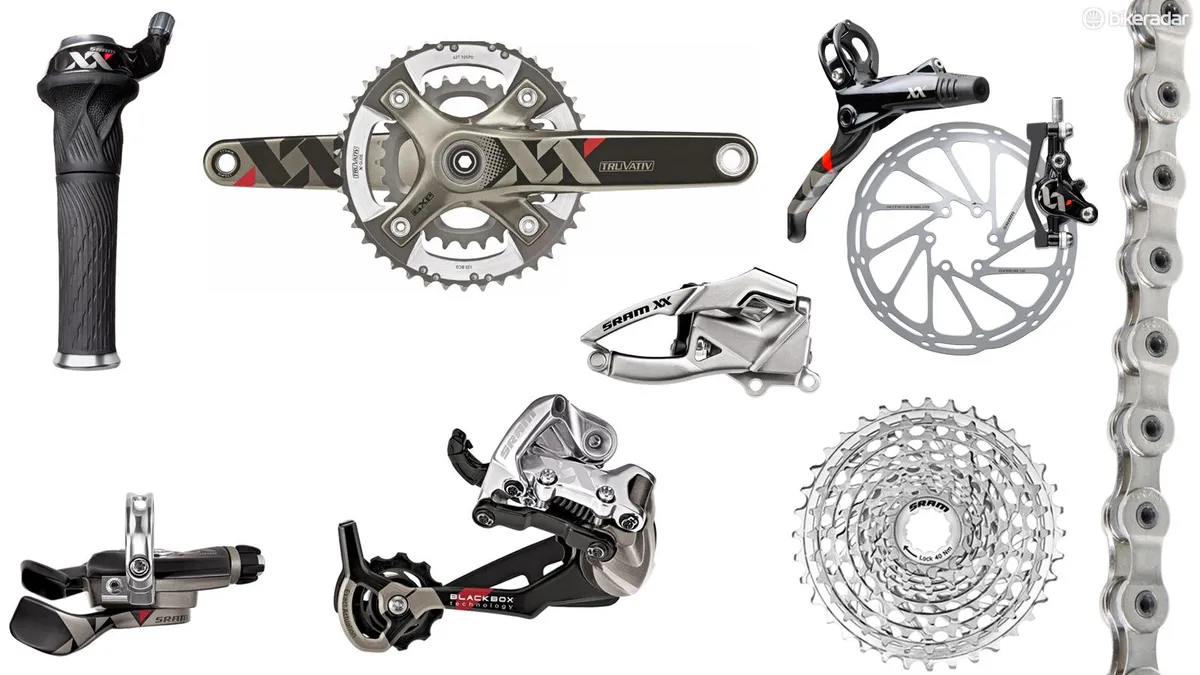
Until the advent of SRAM's 1x11 systems, the XX group was the company's premier off-road drivetrain. It was a dedicated 2x10 group and made extensive use of carbon fibre and titanium hardware to maximise weight savings.
The XX groupset has now been discontinued.
SRAM XX1
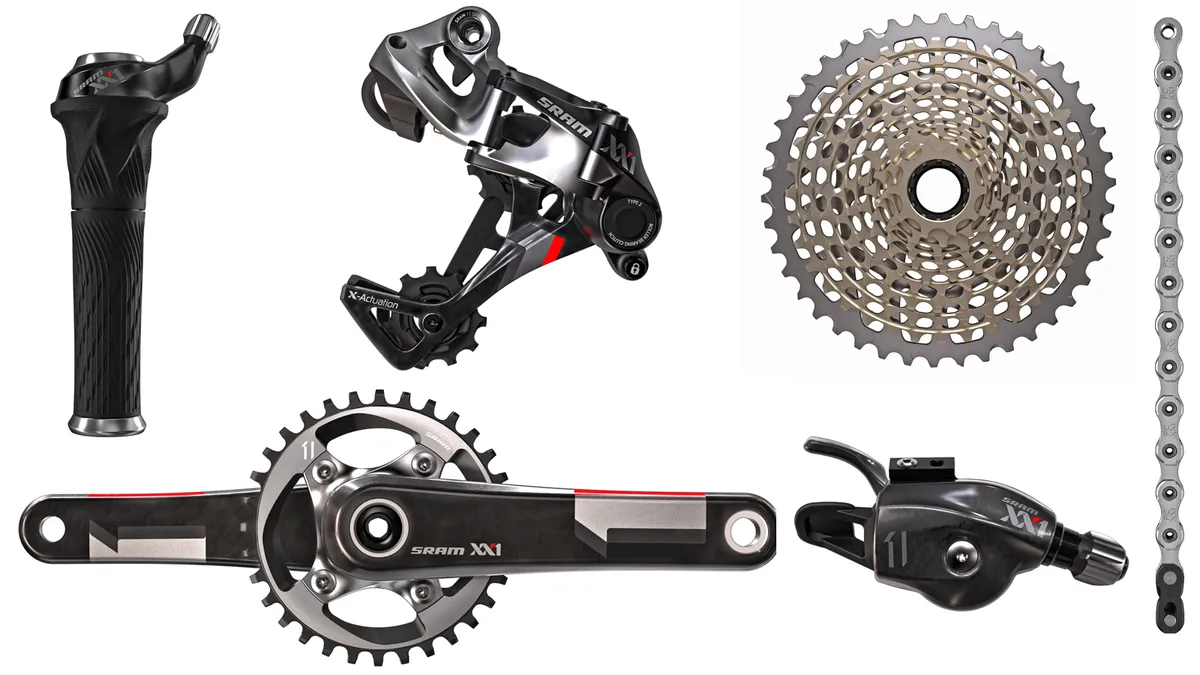
This is SRAM's top 1x11 speed group. It was the group that led the 1x revolution when it was introduced in 2012.
Only the trigger shifter, grip shift shifter and rear derailleur along with an 11-speed chainring, chain and cassette are still available to buy.
SRAM XX1 Eagle
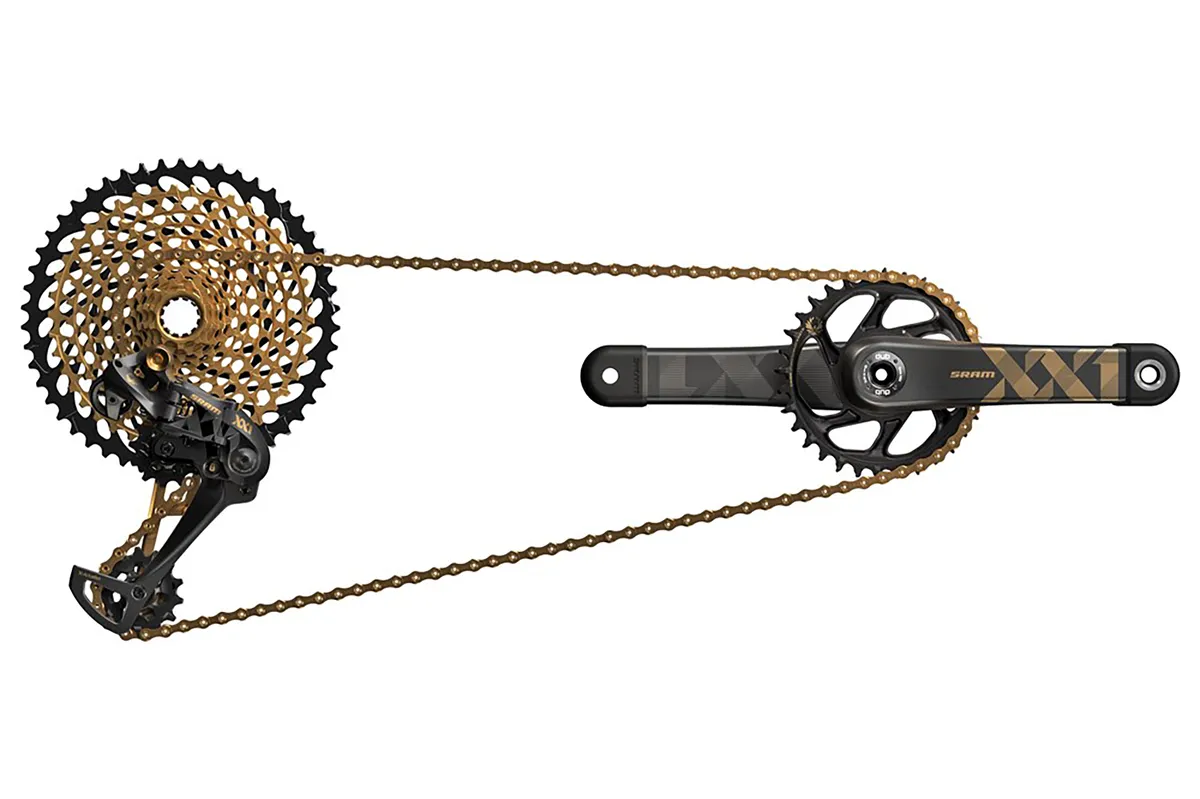
XX1 Eagle is positioned as the top-end group for cross-country racers.
Over the lower-specced X01 Eagle, the XX1 Eagle cassette and chain have gold titanium nitride coatings, which are claimed to increase durability.
The XX1 Eagle derailleur uses a carbon outer plate on the derailleur cage, and the cranksets are slightly different as well; the XX1 Eagle crankset is hollow.
The difference in weight between these two groups is minimal.
Like the 2020 updates to SRAM's GX Eagle and X01 Eagle groupsets, the XX1 Eagle groupset was also updated with a larger 10-52-tooth cassette and a new 52-tooth compatible mech.
SRAM XX1 Eagle AXS
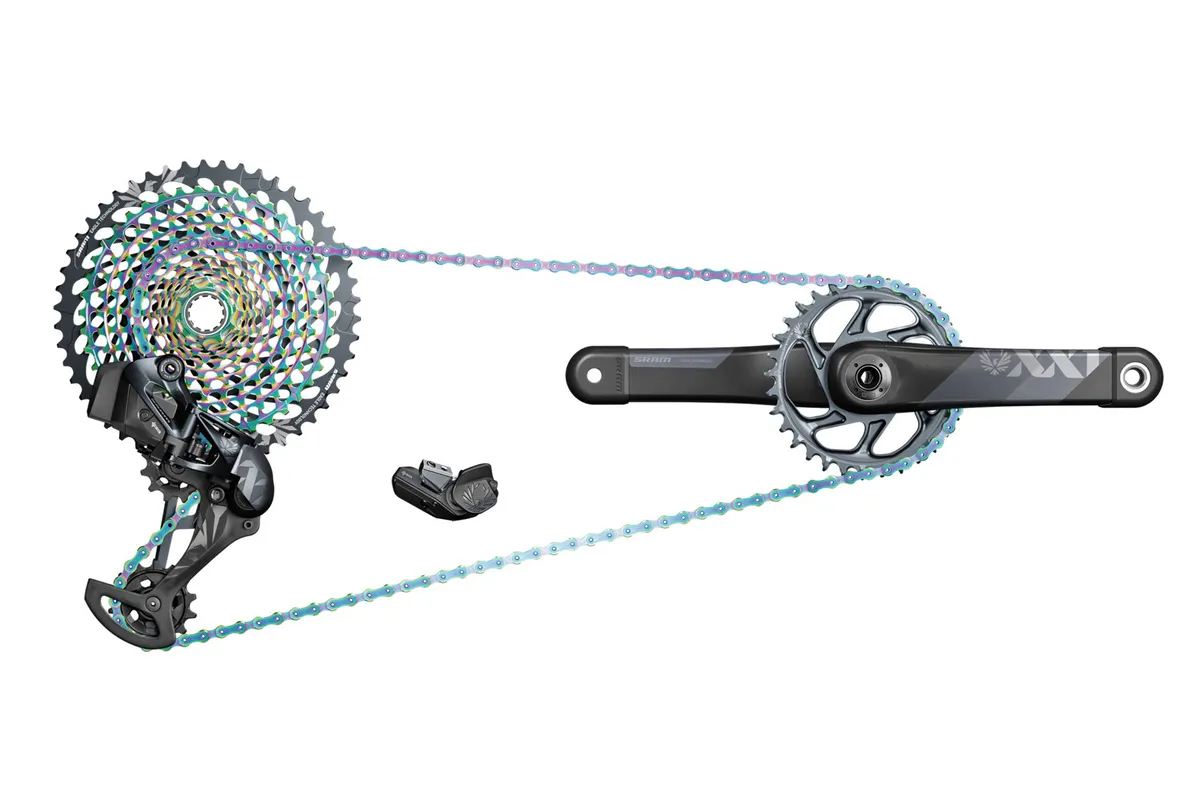
Having had a wireless option on the road for some years, SRAM released wireless versions of its top two mountain bike groupsets in 2019: XX1 Eagle AXS and X01 Eagle AXS.
Along with the obvious advantages of not having to muck around with cables, AXS brings a clever new shifter design and a derailleur equipped with a second clutch, which allows it to move in the event of sudden impact, limiting damage. There's also a matching wireless AXS Reverb dropper post.
SRAM X0 T-Type Eagle AXS
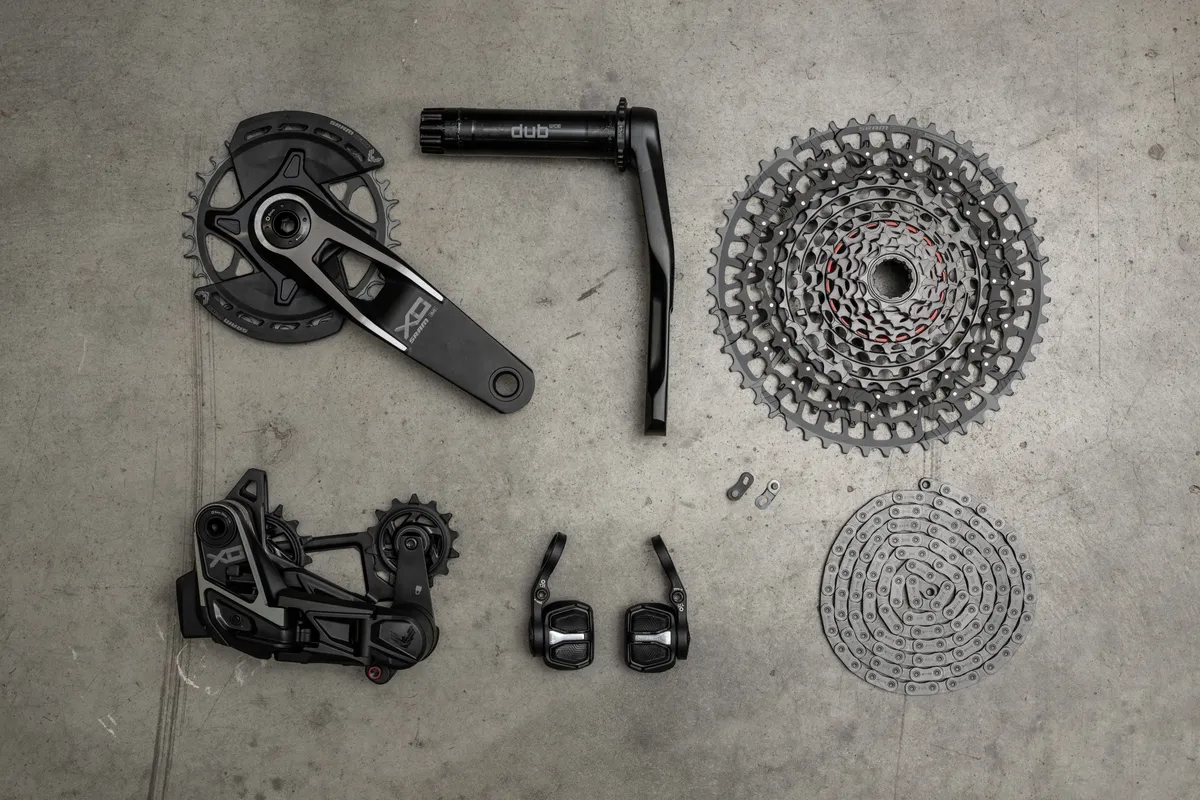
X0 T-Type Eagle AXS is wireless and the entry level into SRAM's new T-Type mounting system released in 2023. The new mounting system utilises the brand's own UDH (Universal Derailleur Hanger) standard and works around the centre of the axle.
X0 T-Type Eagle AXS is only available as a 1x, and has a maximum chainring size of 32-tooth. The rear derailleur can run up to a 52-tooth cassette.
The aluminium crankset features a bash guard, and the groupset is approved for electric mountain bikes.
SRAM XX T-Type Eagle AXS

SRAM's XX T-Type Eagle AXS is all-new, and uses the brand's new mounting system, removing the need for a derailleur hanger.
The XX T-Type is designed for 1x trail and enduro bikes, with the carbon cranks available in 165/170/175mm lengths and a 32-tooth chainring.
The cassette features X-Sync, which allows for shifting under power and the rear derailleur is compatible with a 52-tooth cassette.
SRAM XX SL T-Type Eagle AXS
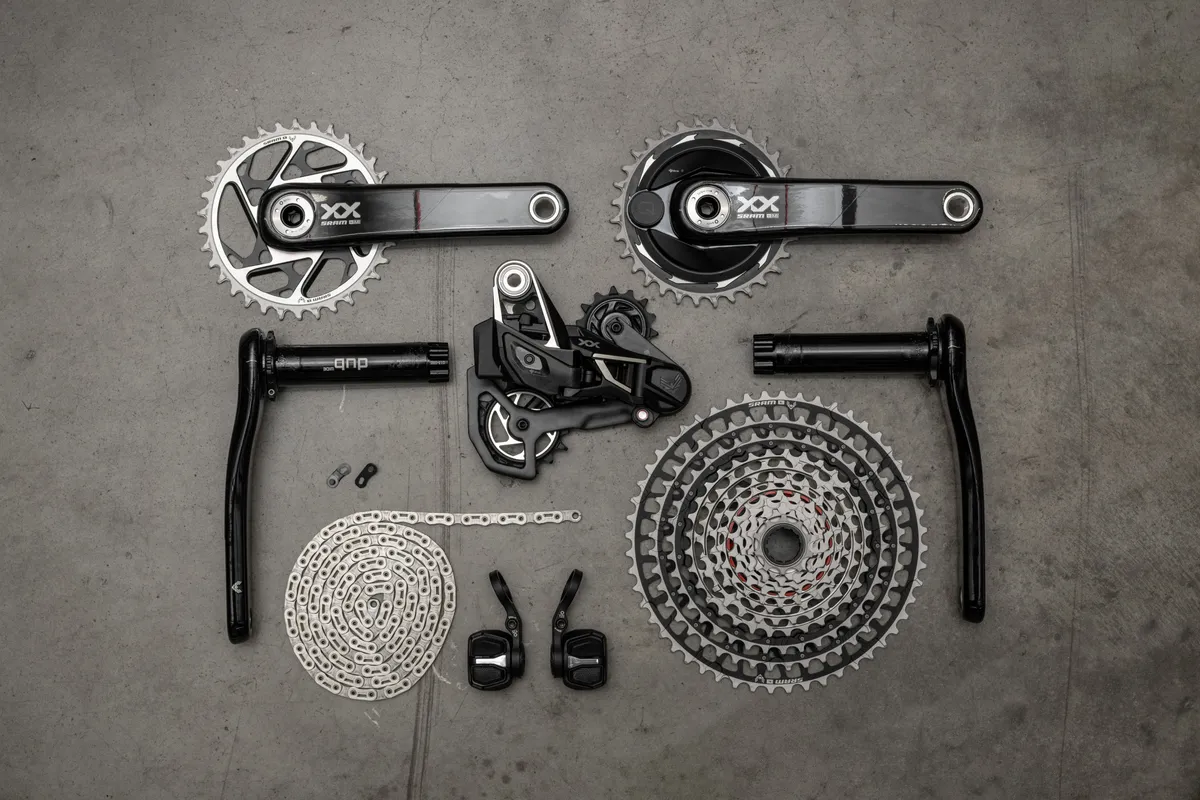
XX SL T-Type is cross-country specific, and is the lightest of SRAM's new T-Type groupsets. The SL is lighter than the XX T-Type, and its carbon crank is available with a 34-tooth chainring. There is also a power meter variant.
The rear cassette features the same X-Sync as the trail-focused XX T-Type, and is 10-50t.
A new AXS Pod ULT makes shifting a two-button affair, as opposed to the three functions on the regular AXS Pods.
SRAM EX1

SRAM's EX1 group was developed specifically for the growing e-mountain market. Electric assistance and its associated rapid shifts put greater stress on components.
To counter this, EX1 features an 8-speed cassette, with the big cog 7mm inwards of where it would be on an 11-speed setup to reduce cross-chaining. This offers an extra-strong chain that's positionally synced with specific teeth to ease strain on the drivetrain while changing gear.
SRAM GX DH

Designed with downhill in mind, the GX DH groupset has seven gears only and the mech can only be used with either the PG-720 or XG-795 cassettes.
The GX DH groupset features a shifter, mech, chain and cassette.
SRAM X01 DH

X01 DH is a purpose-built groupset for downhill racing and is available as either a 7- or 10-speed setup.
What about Microshift groupsets?
Microshift groupsets usually feature on low- to mid-price bikes, with the brand offering the Acolyte, Advent and Advent X.
Similar to Shimano's Cues range, Microshift groupsets use the same cable pull ratio across the range, allowing for components to be mixed and matched.
The brand also makes replacement parts for Shimano groupsets.
If you're interested in learning more about Microshift, why not check out our buyer's guide to Microshift.
